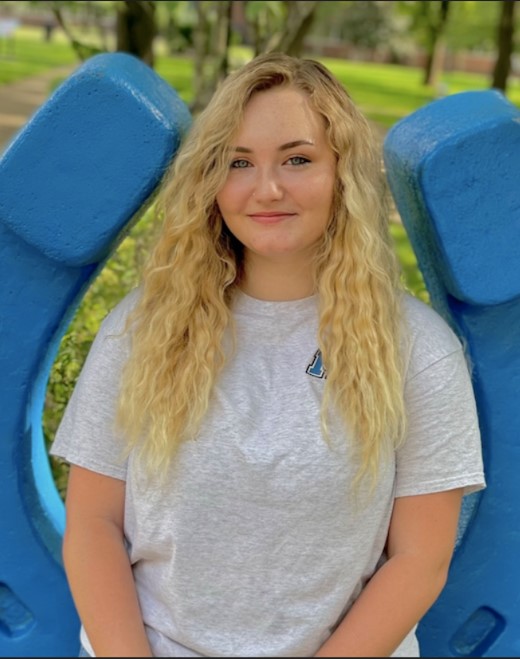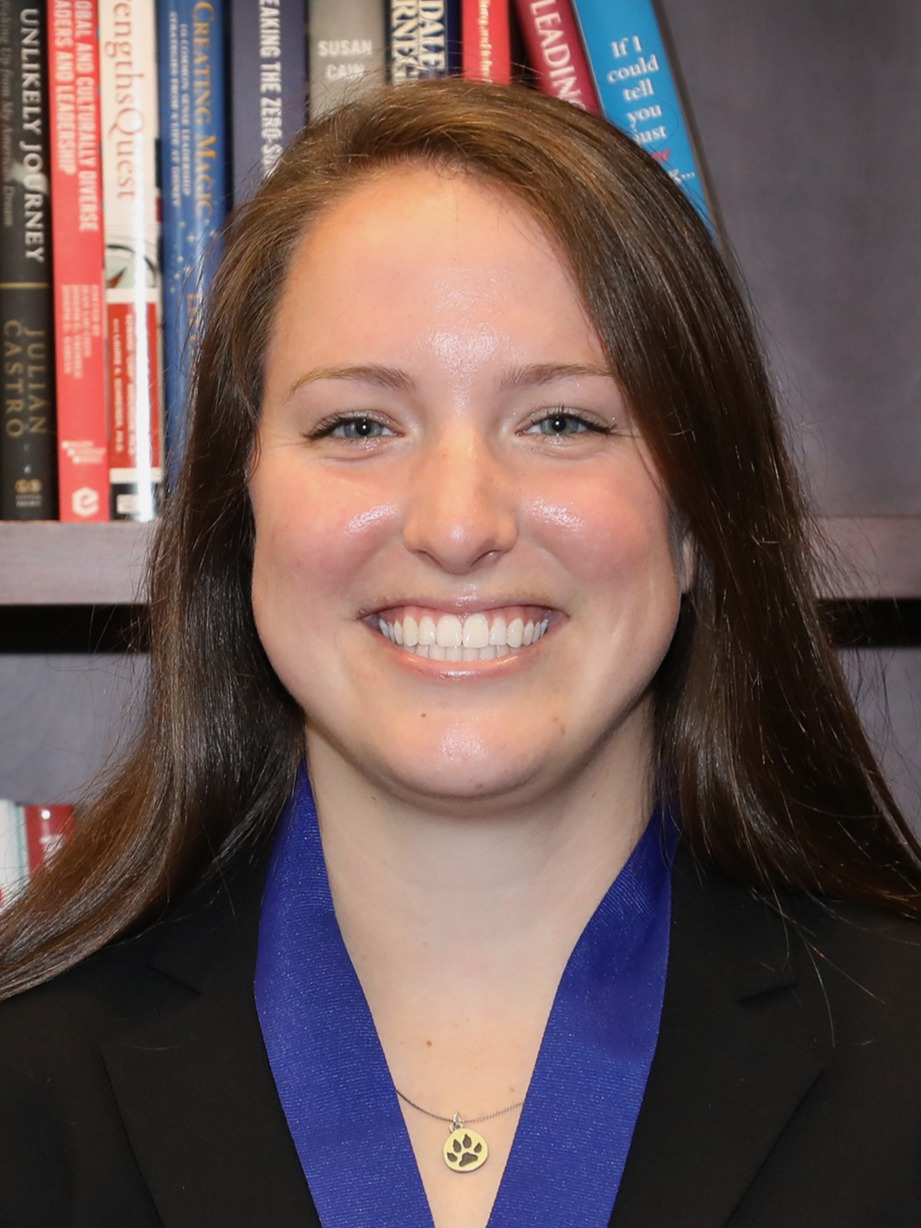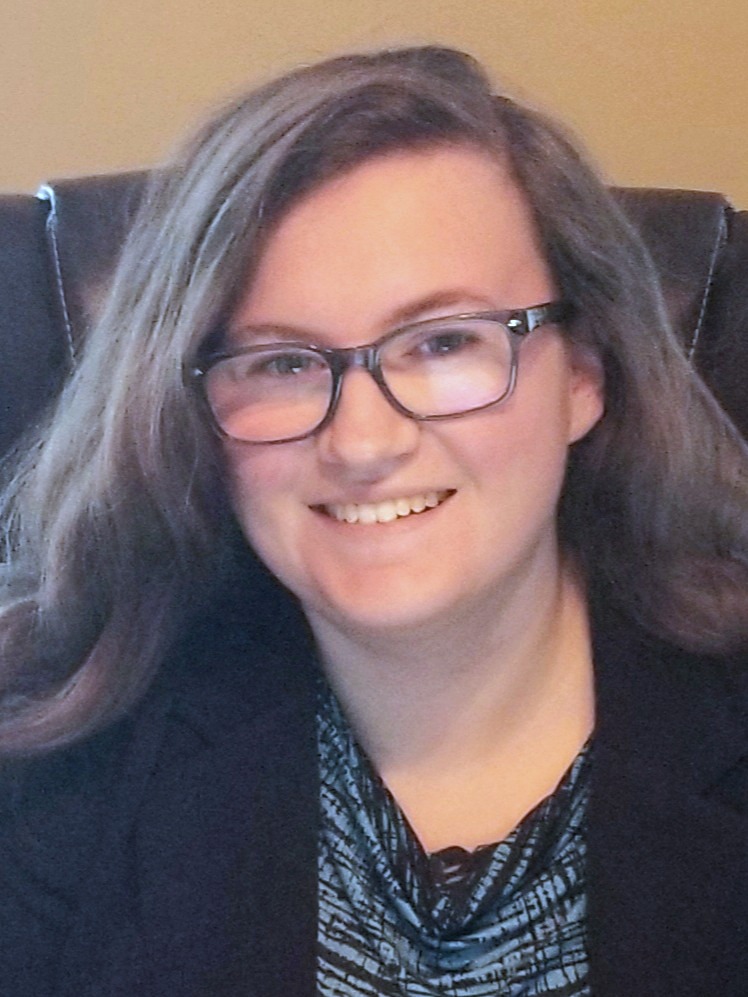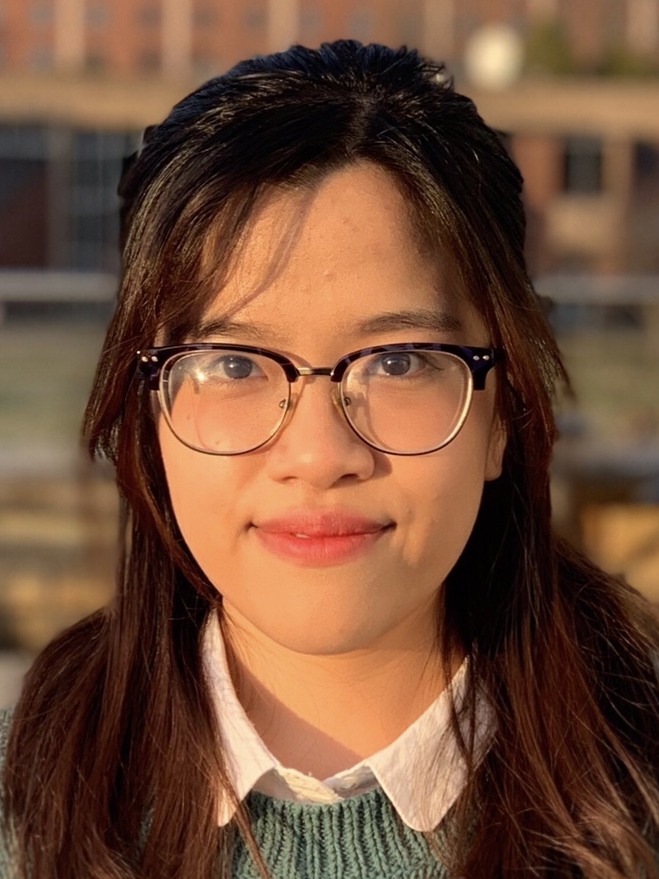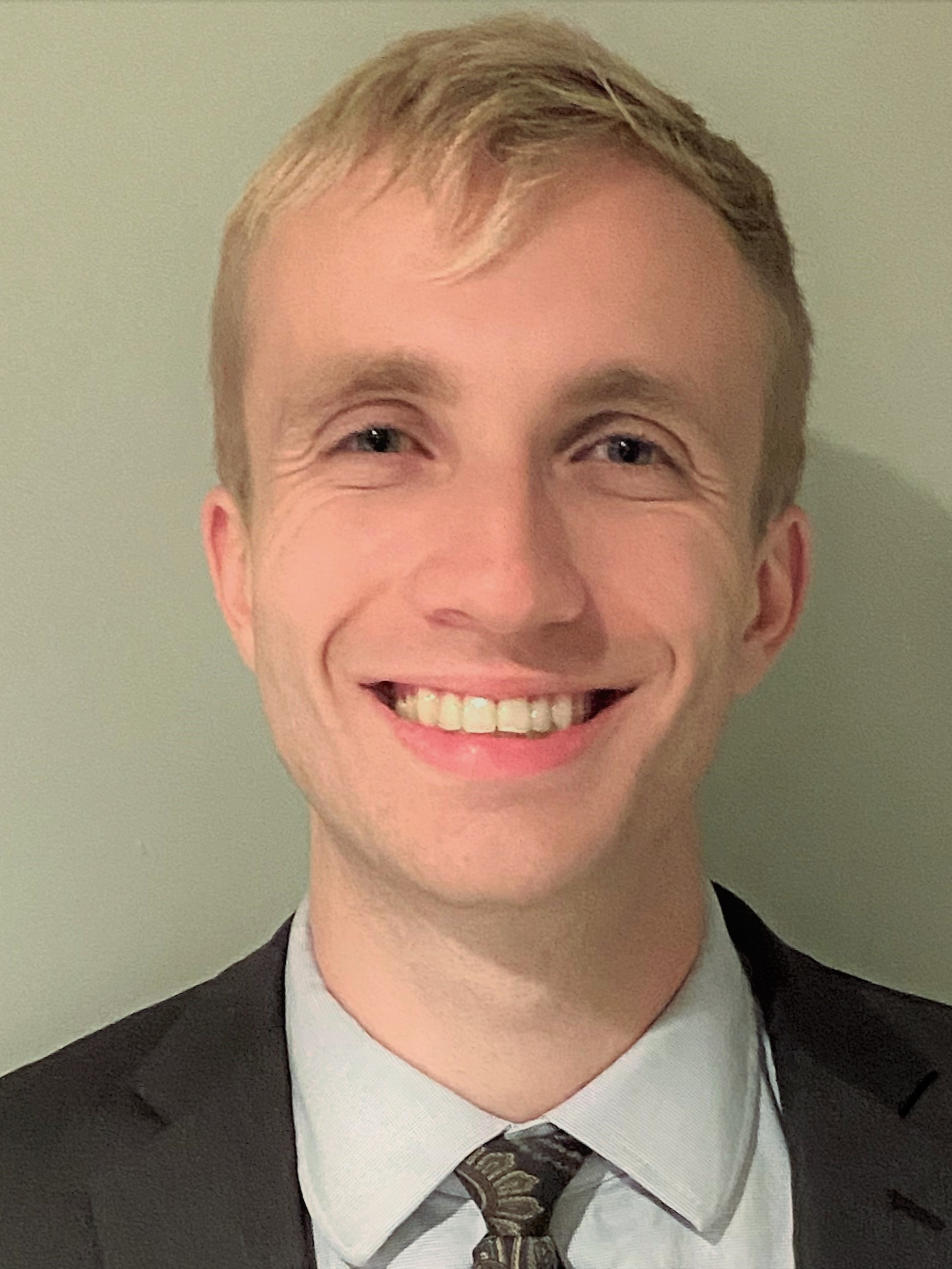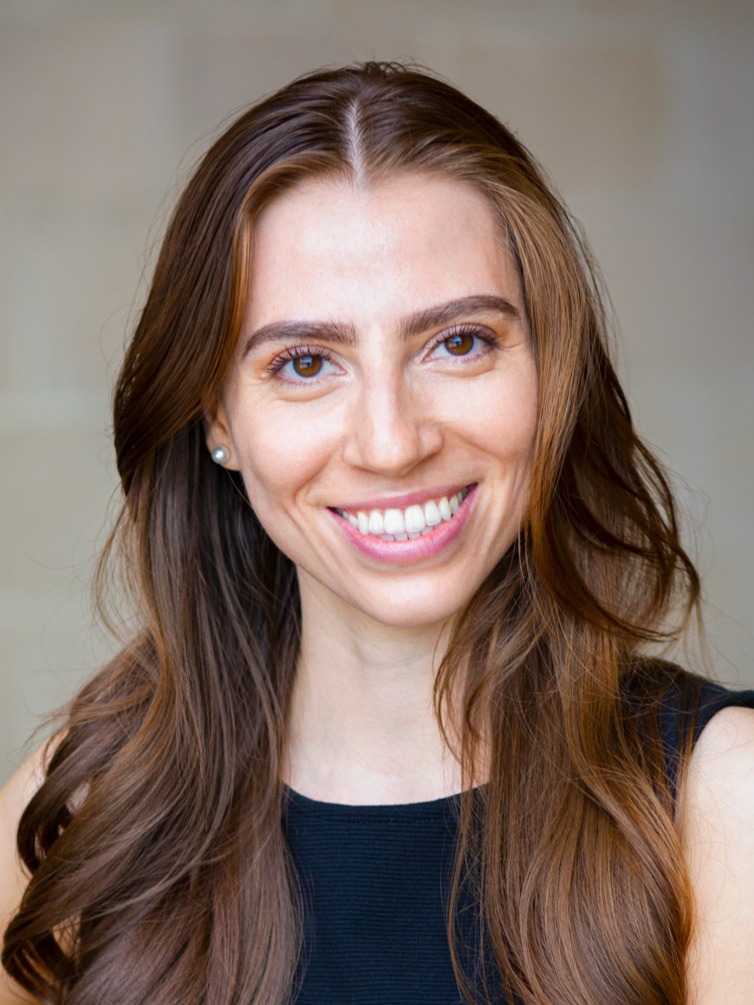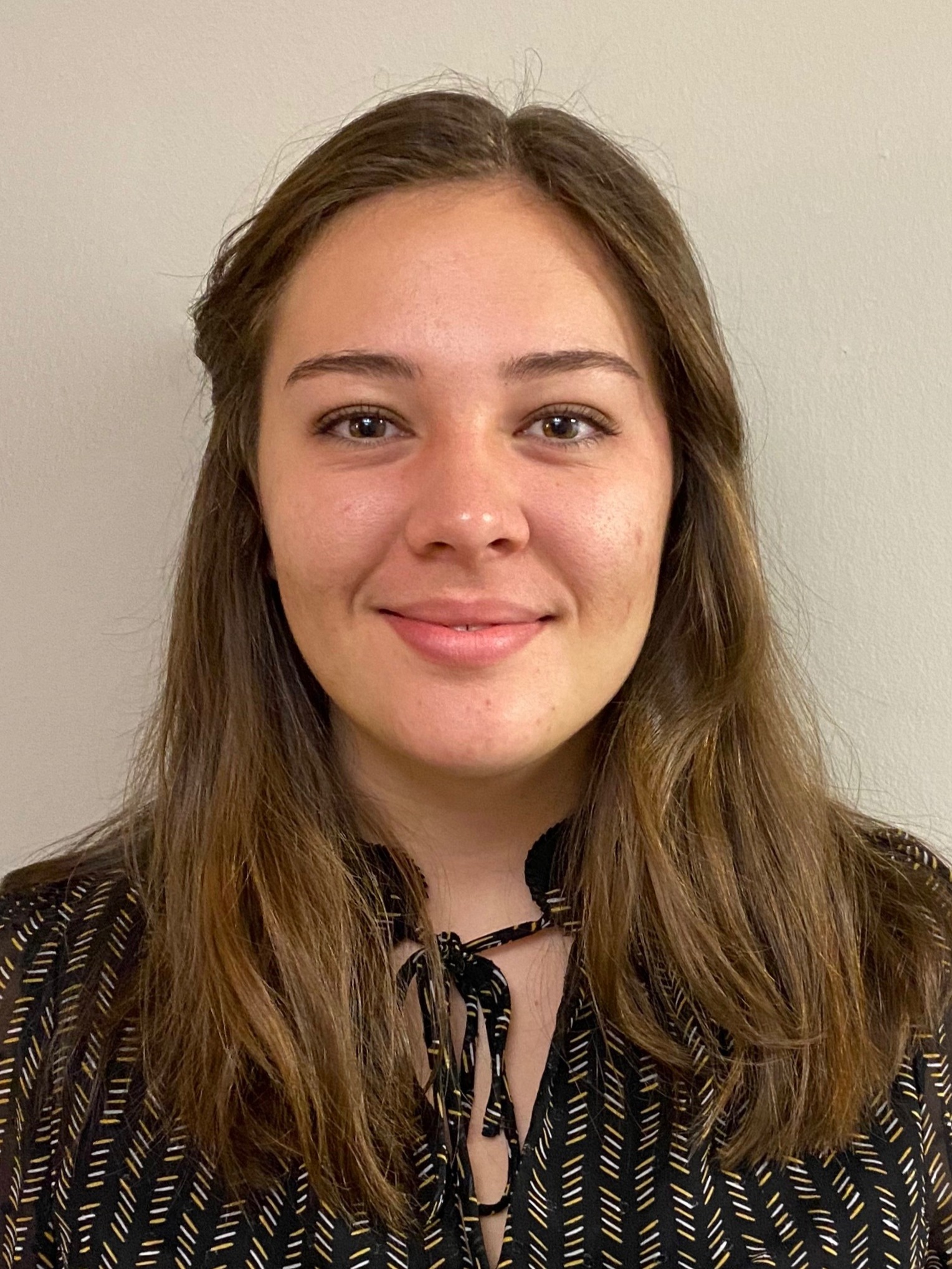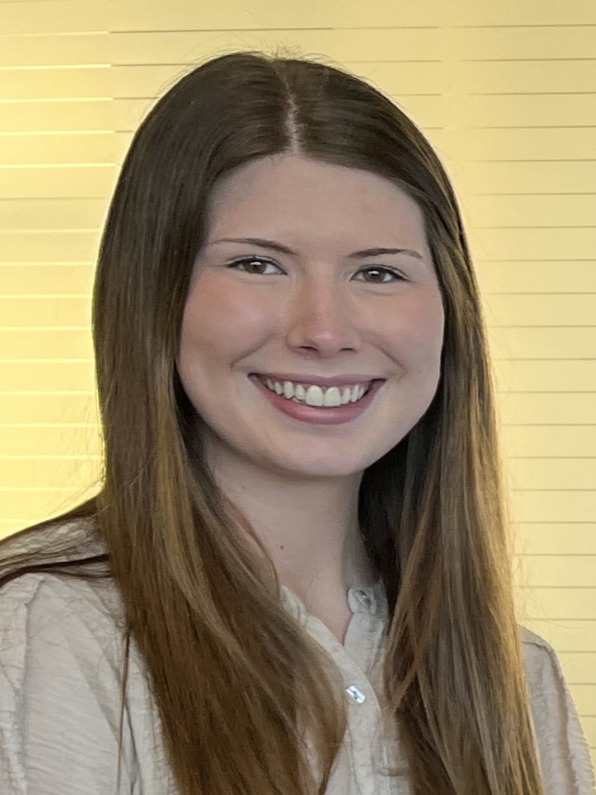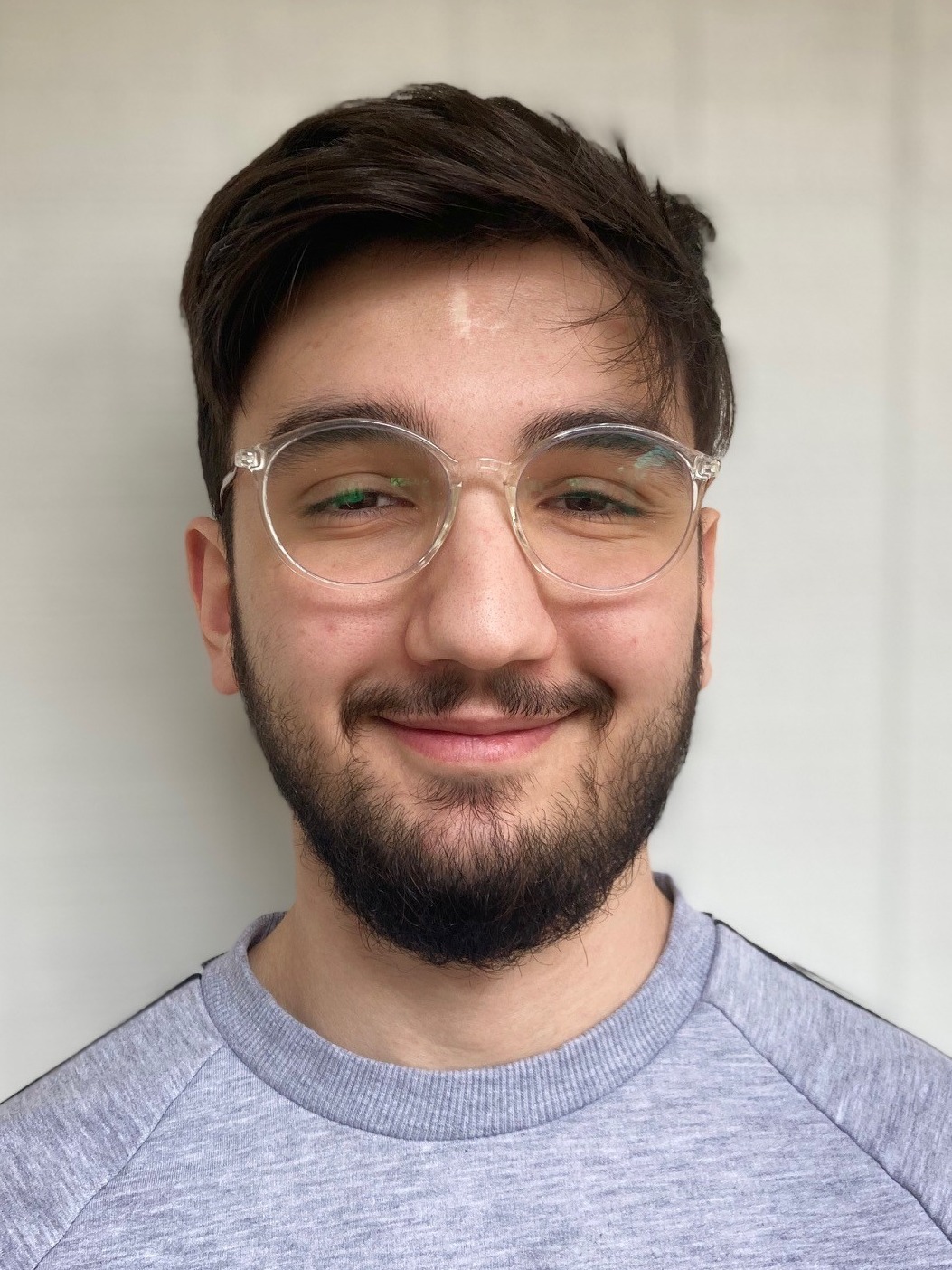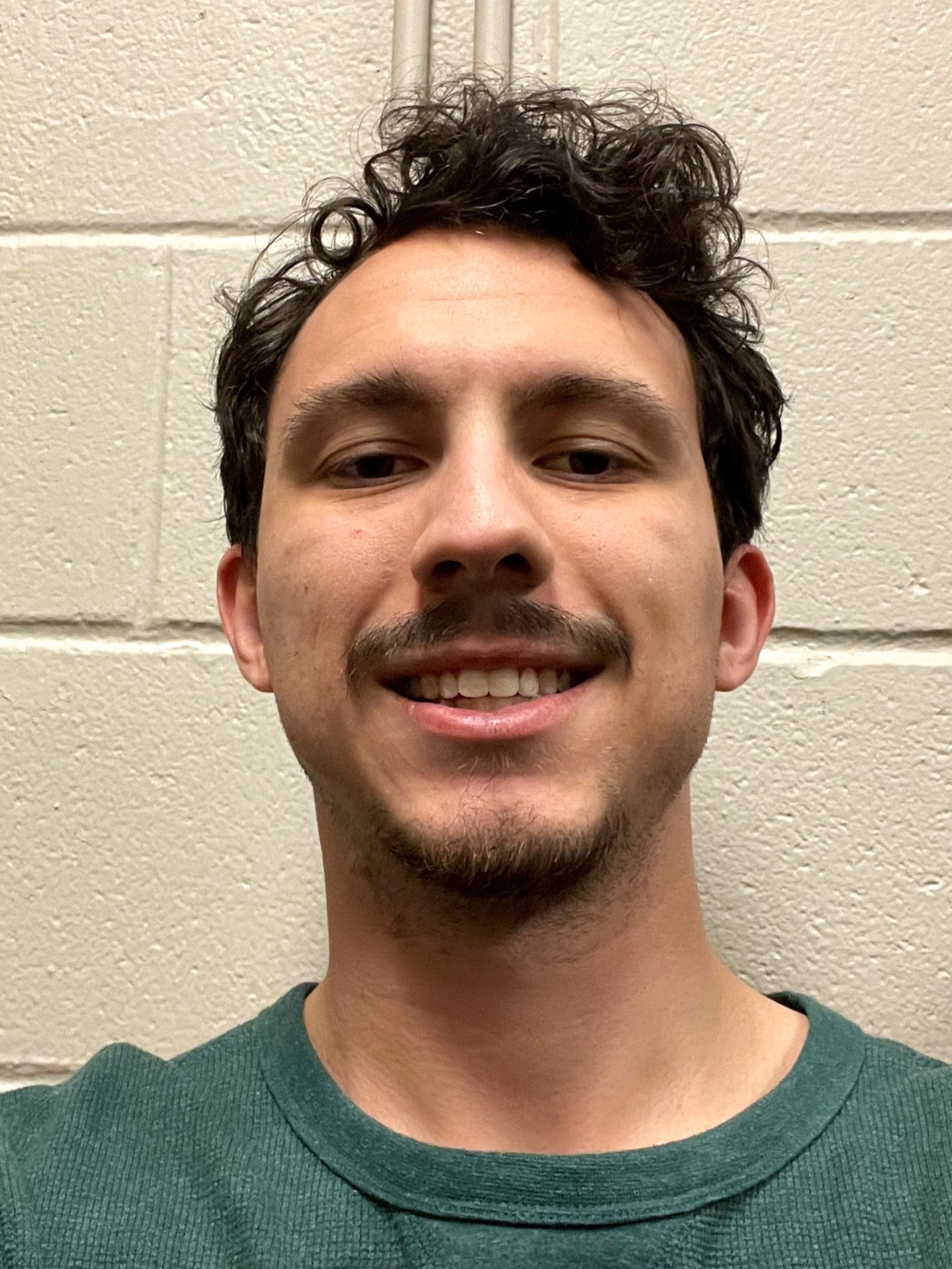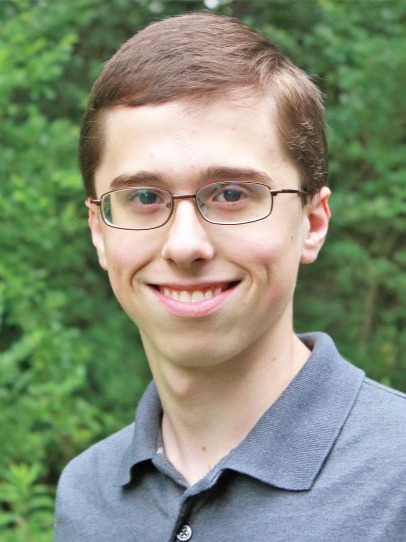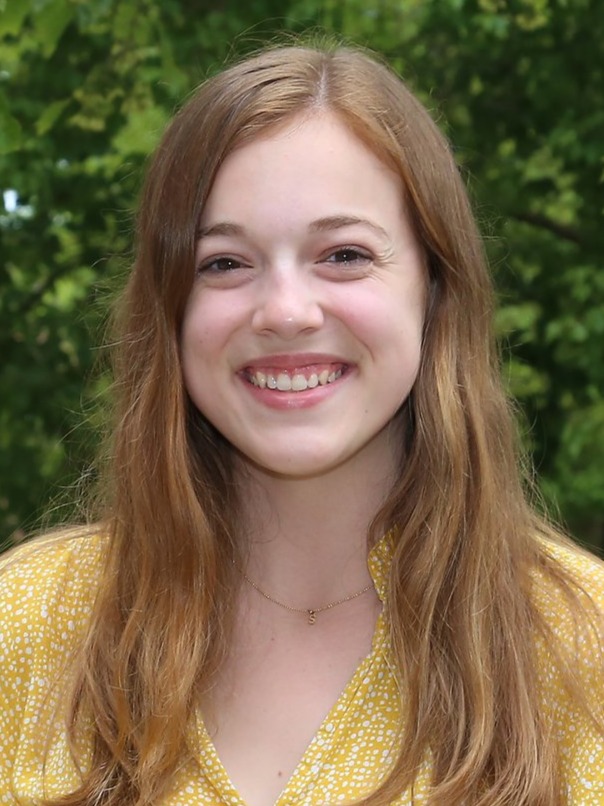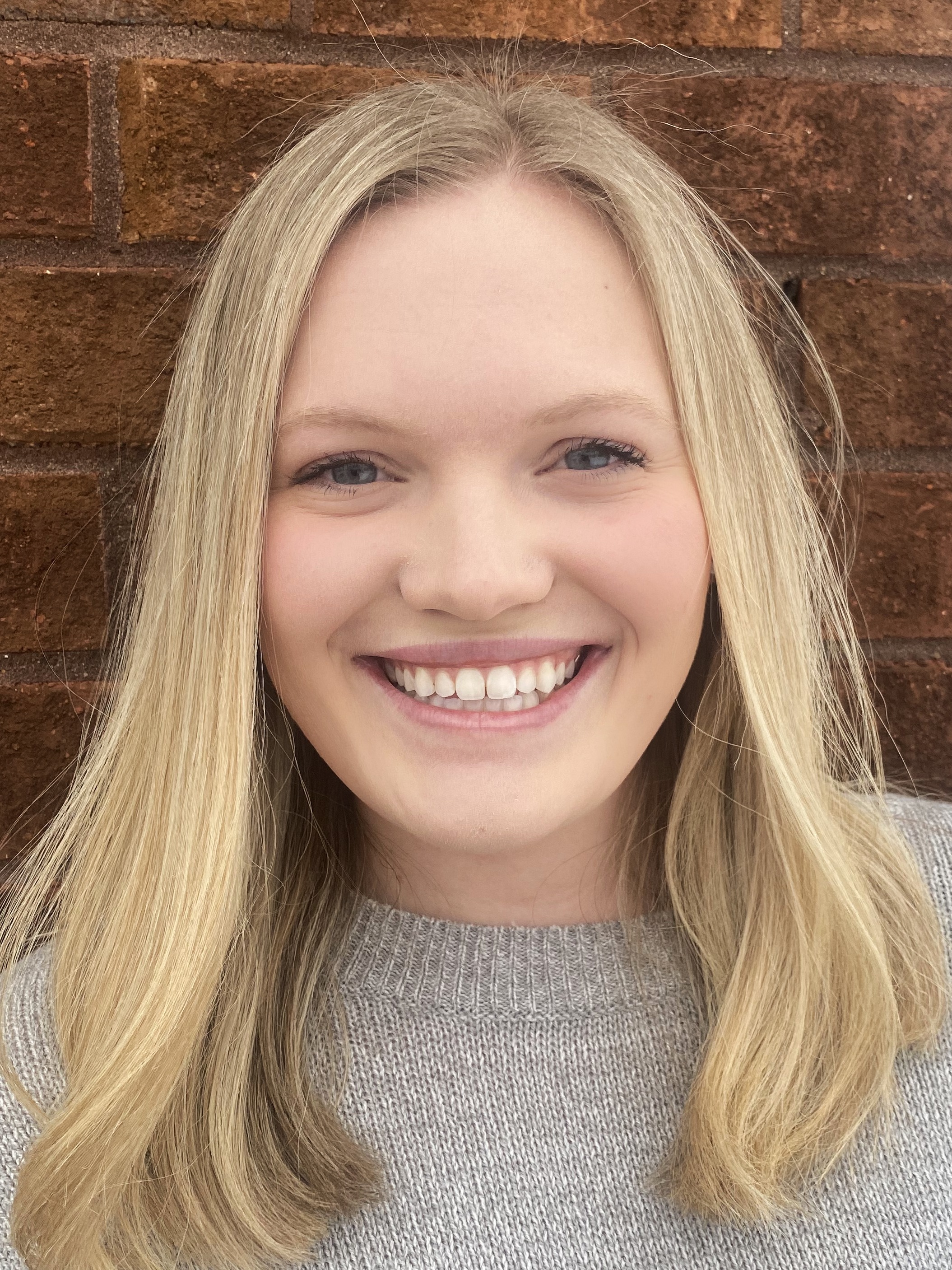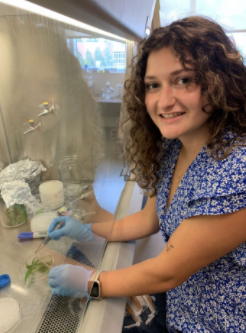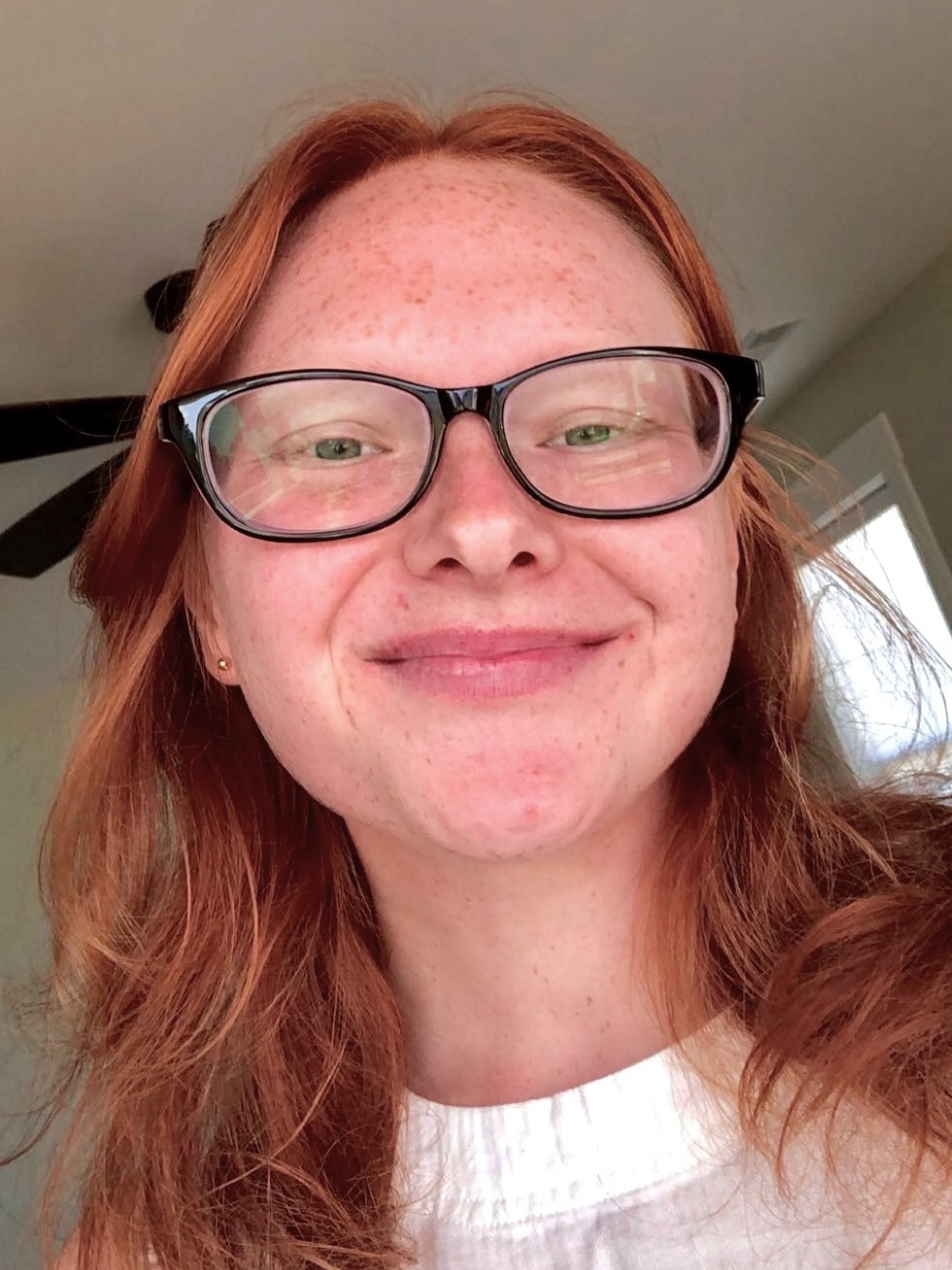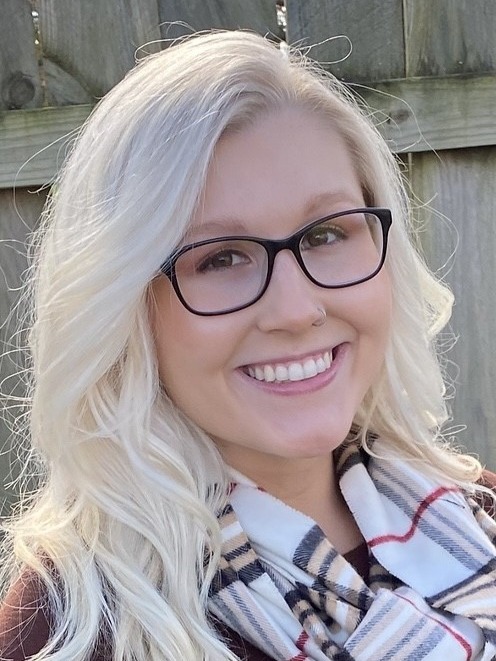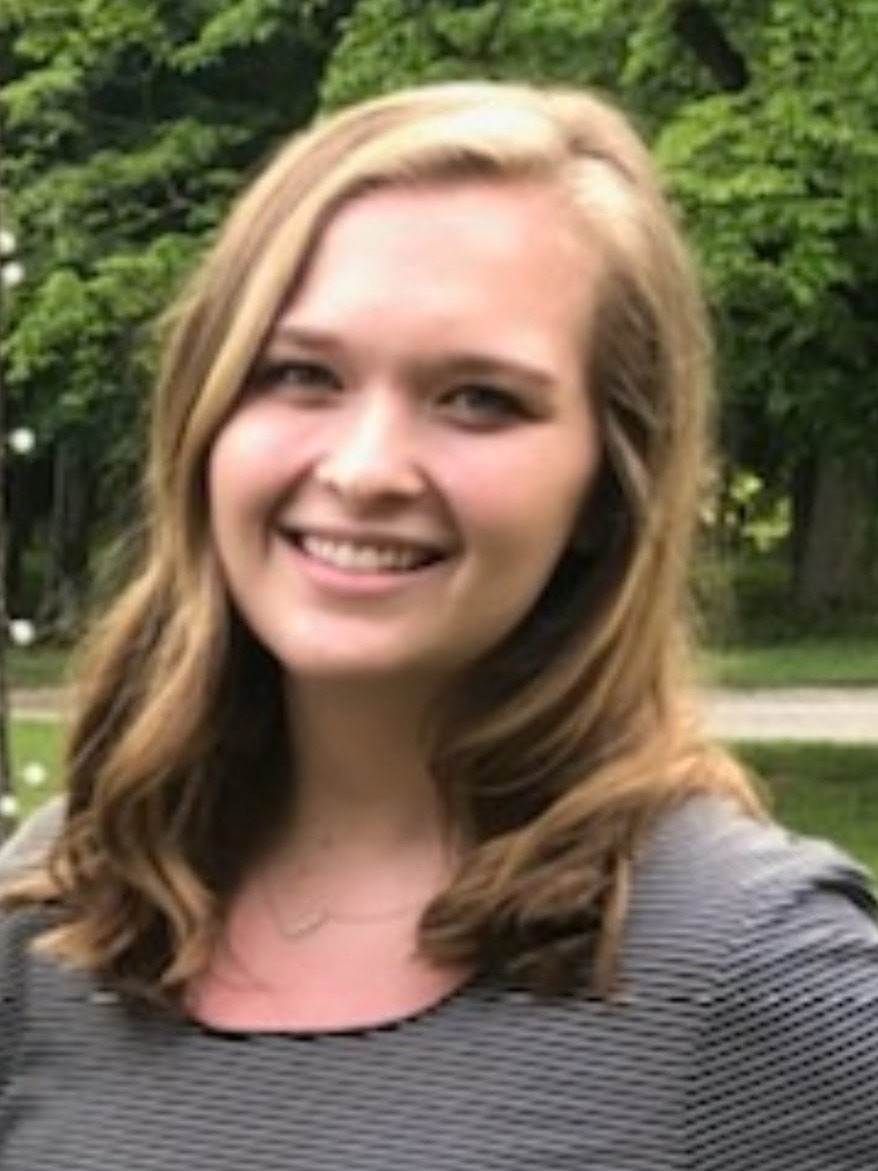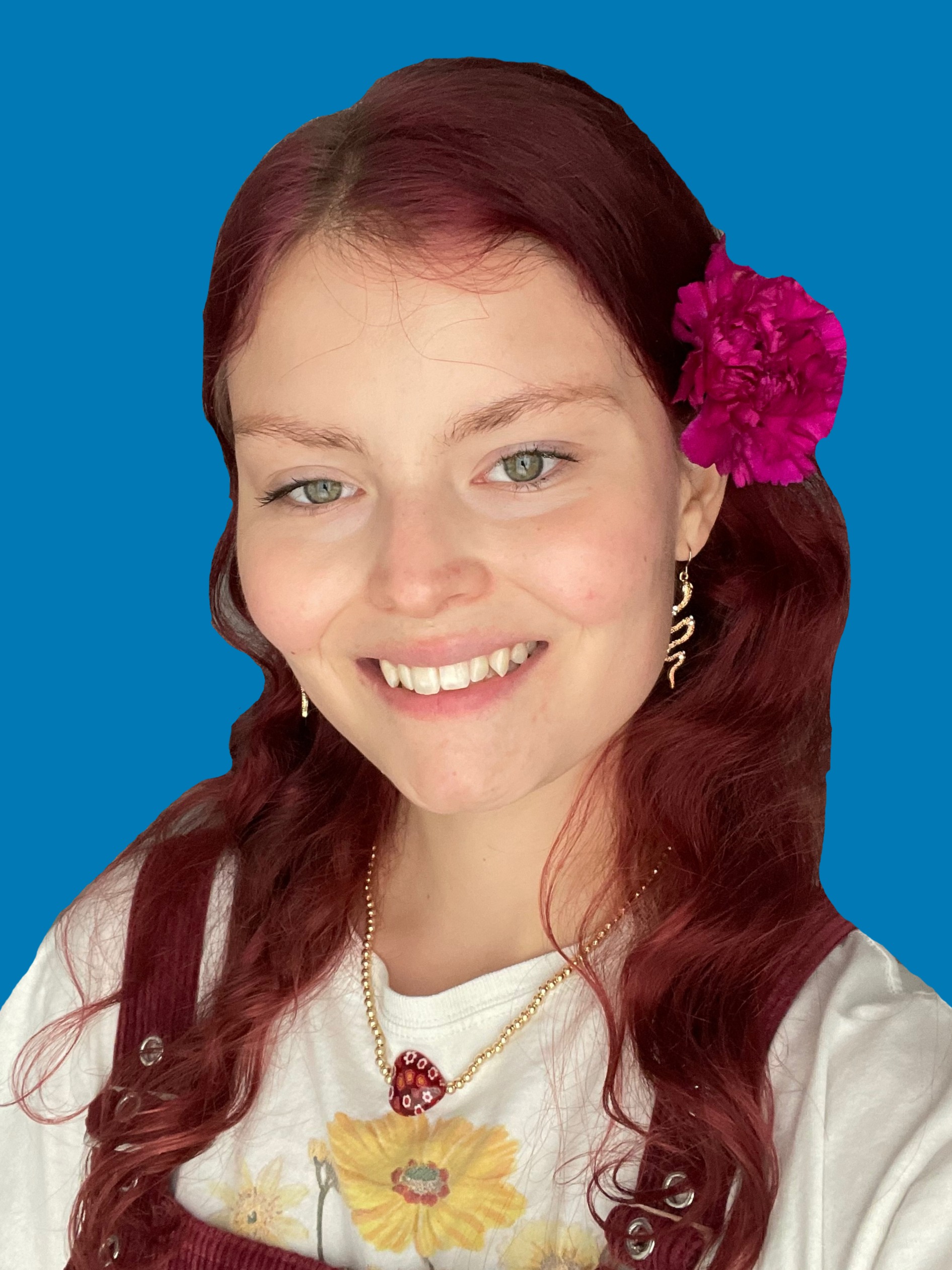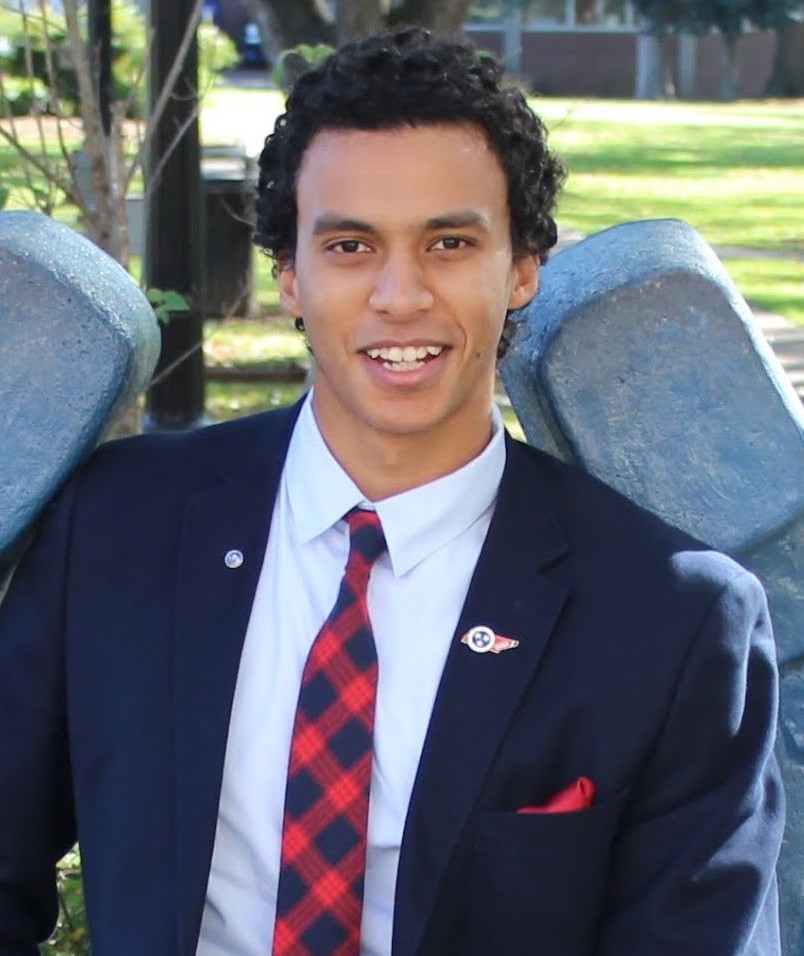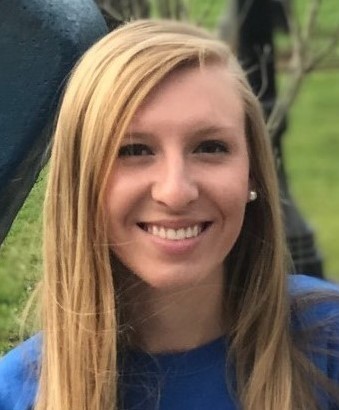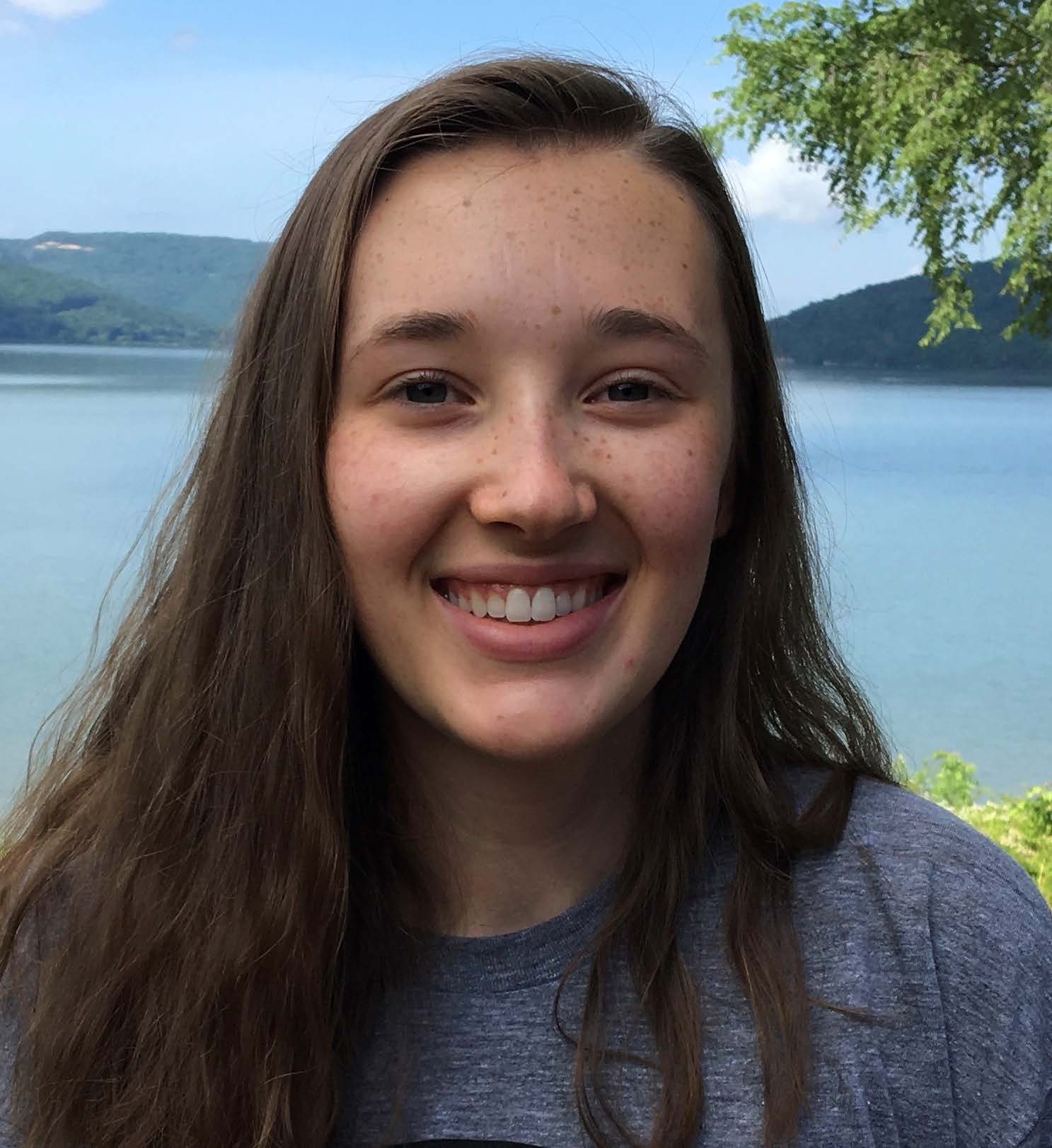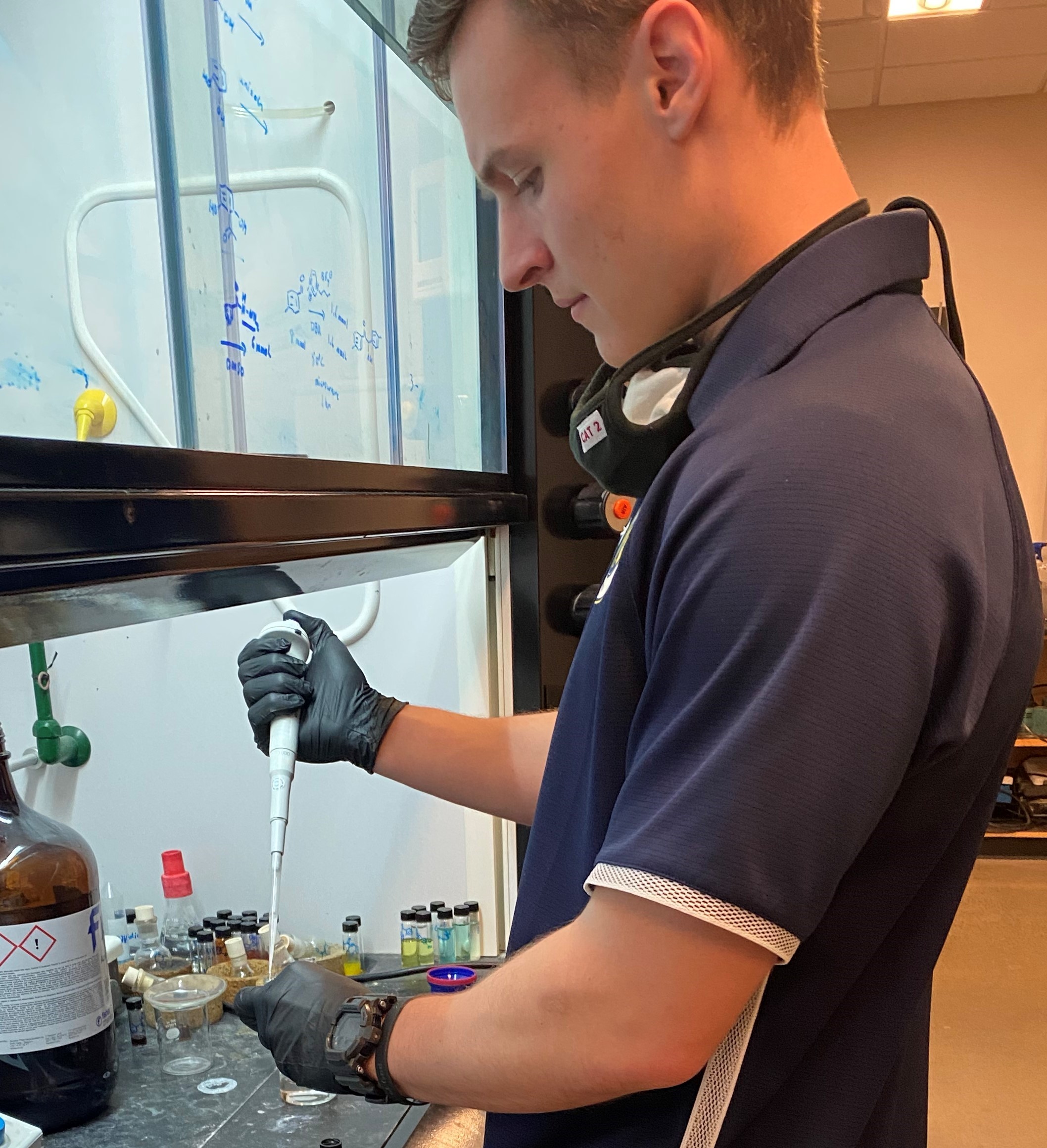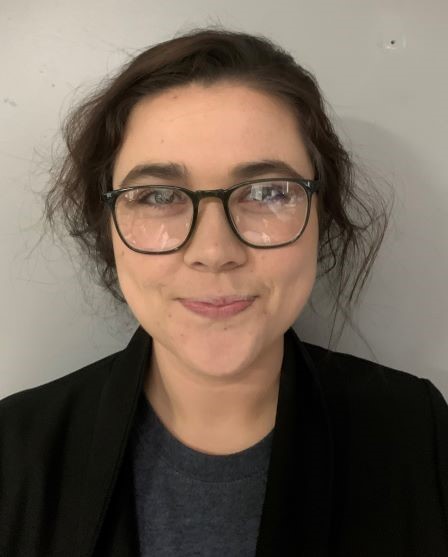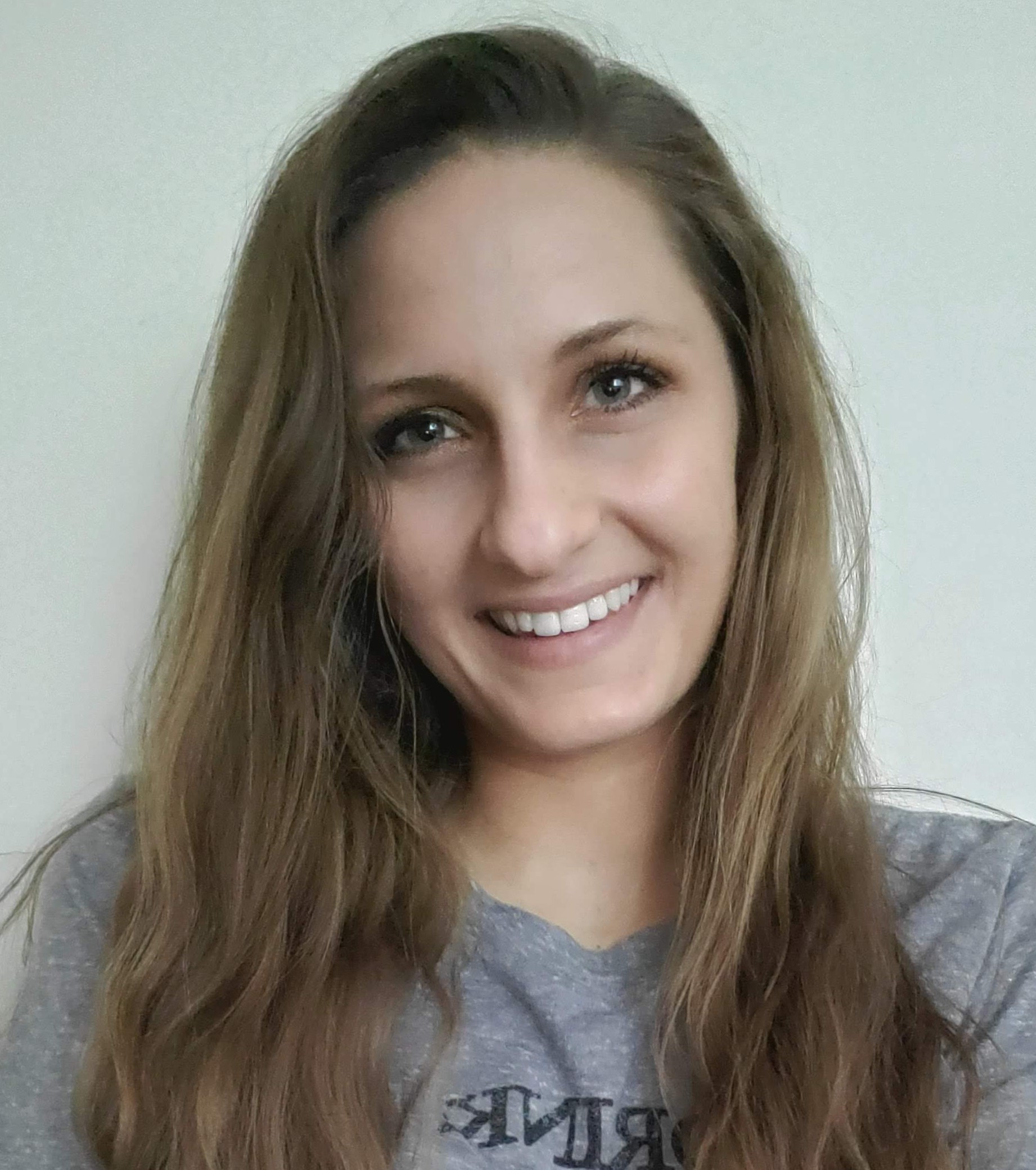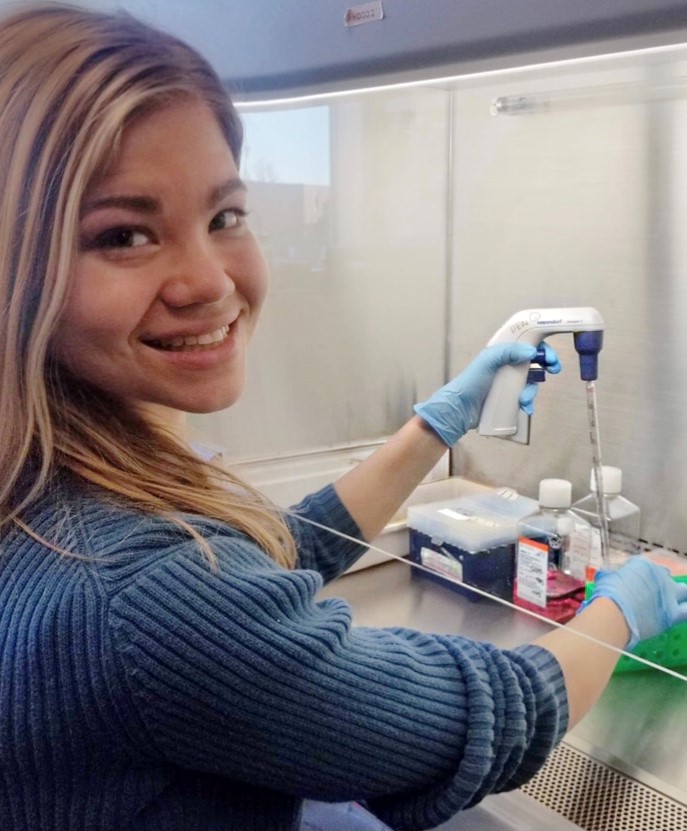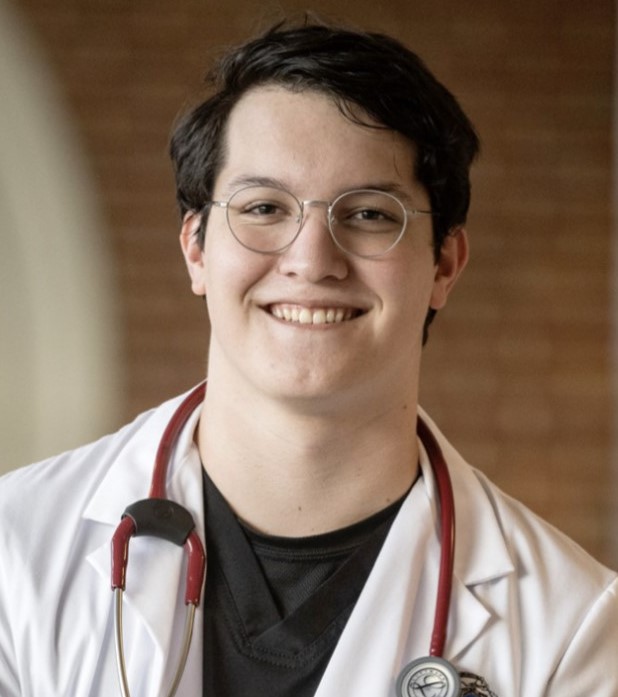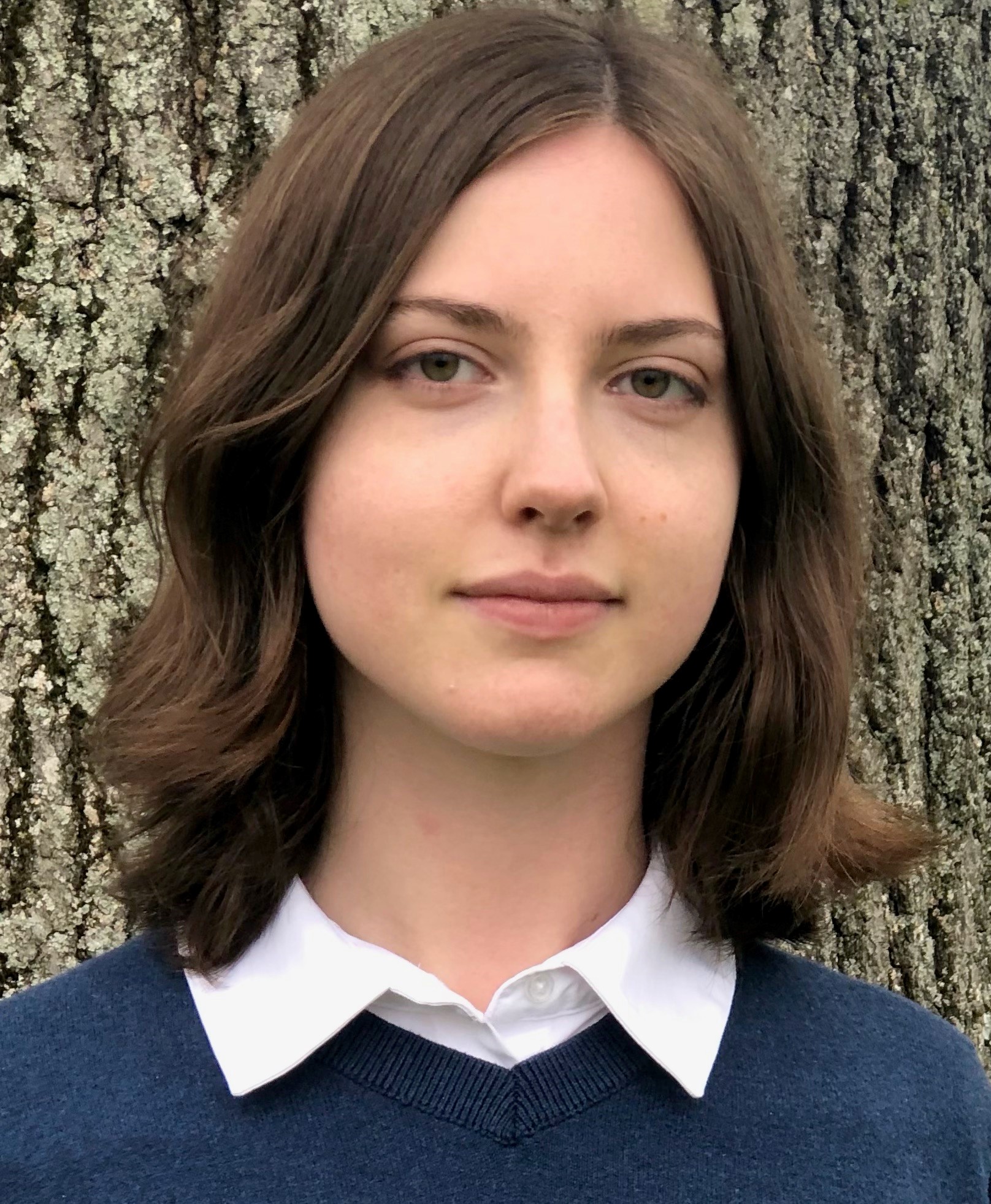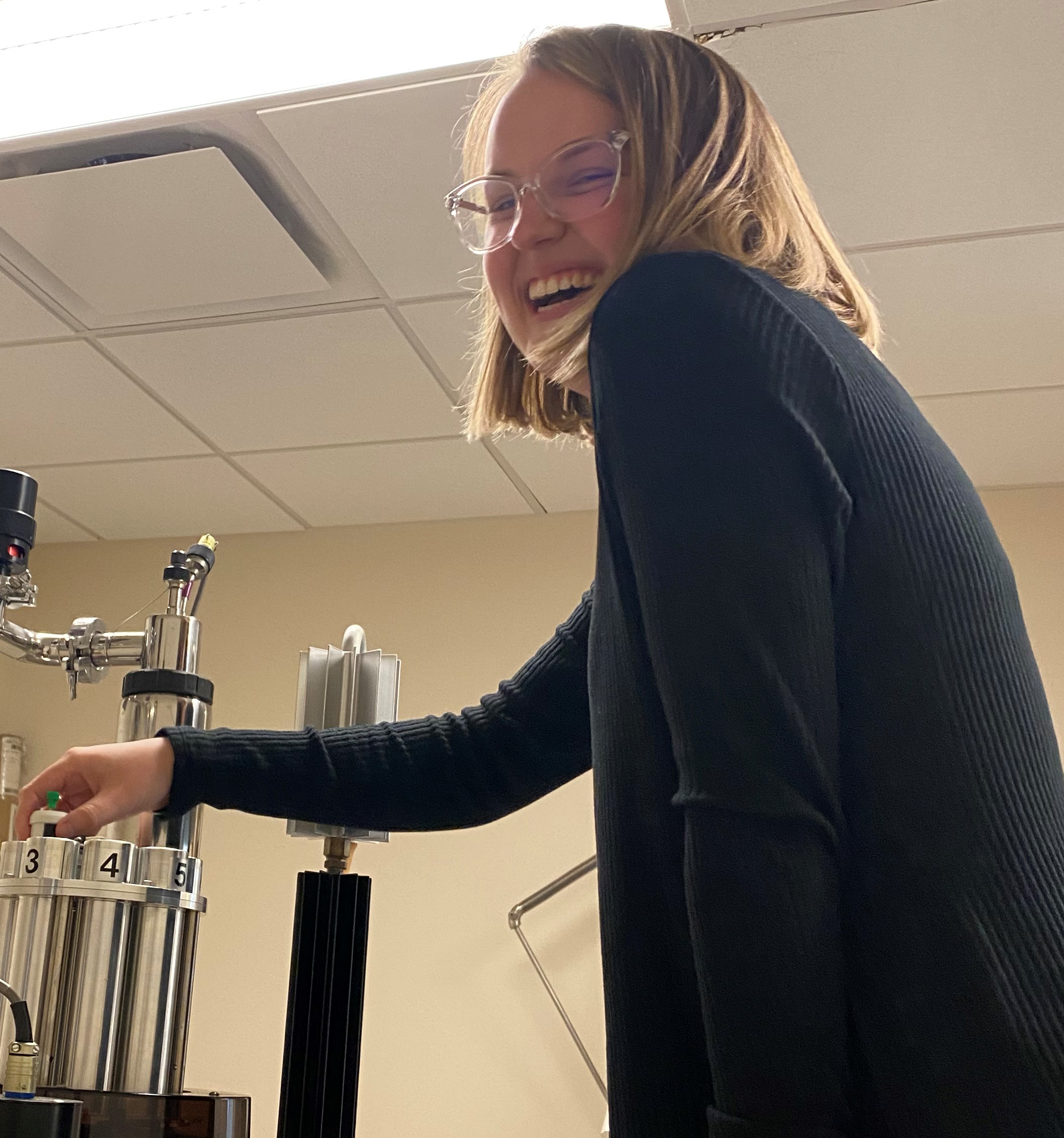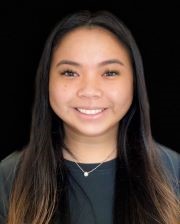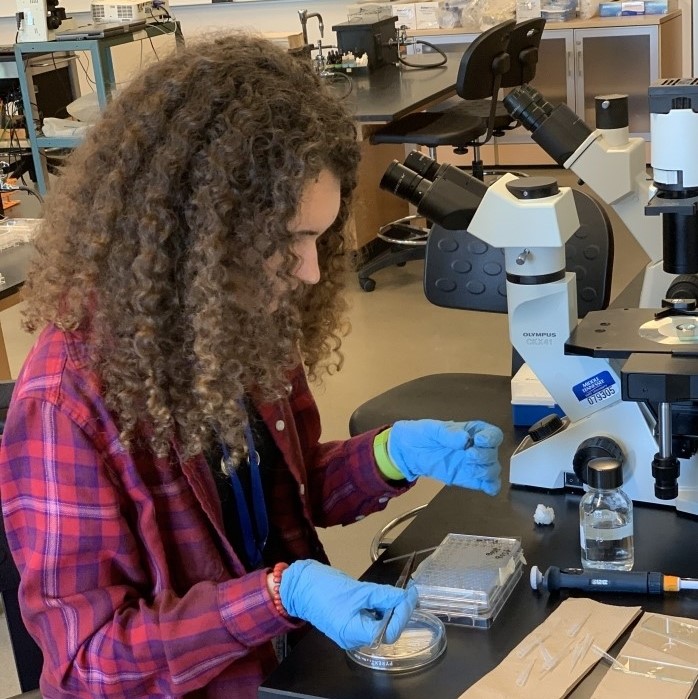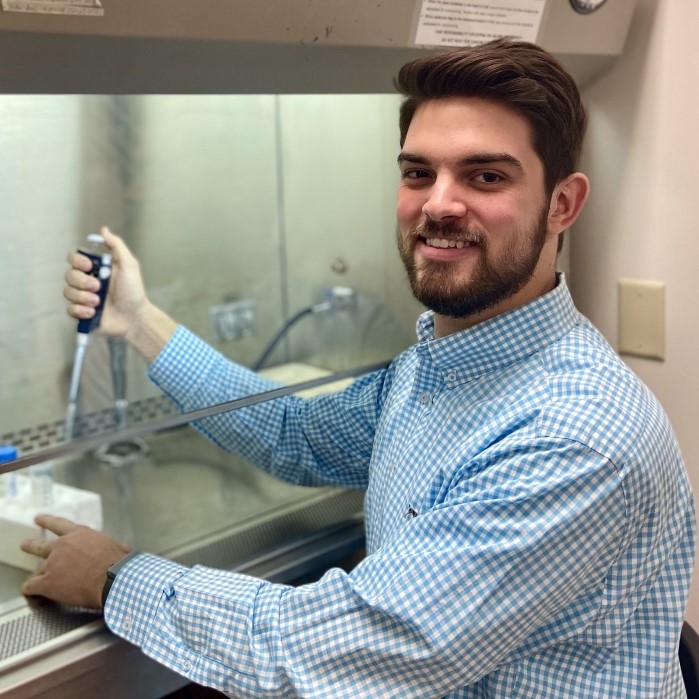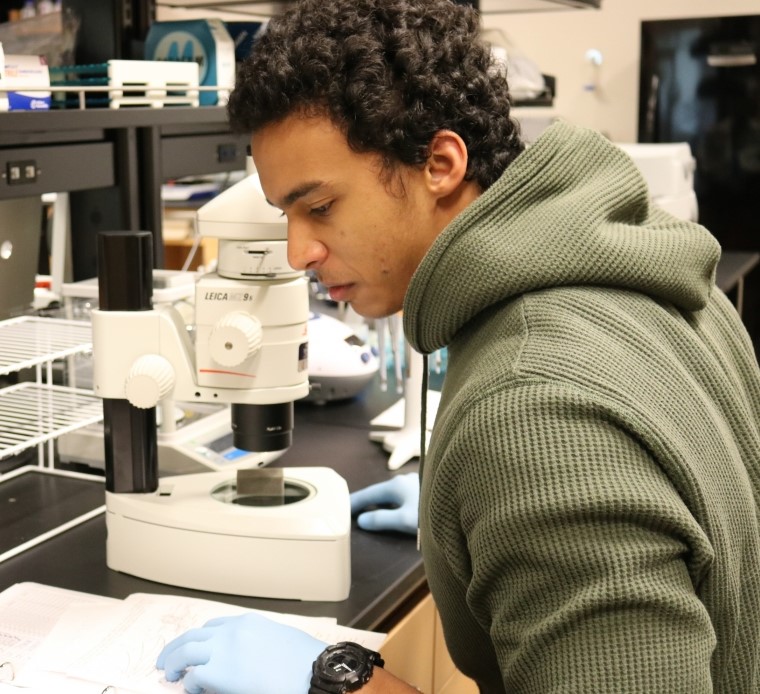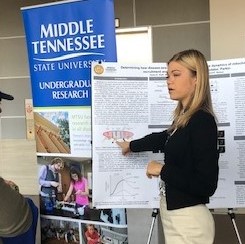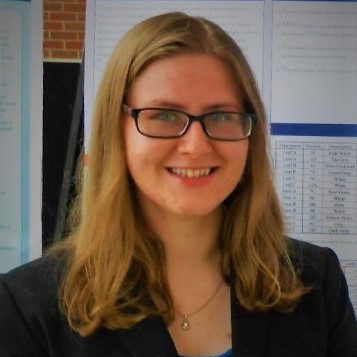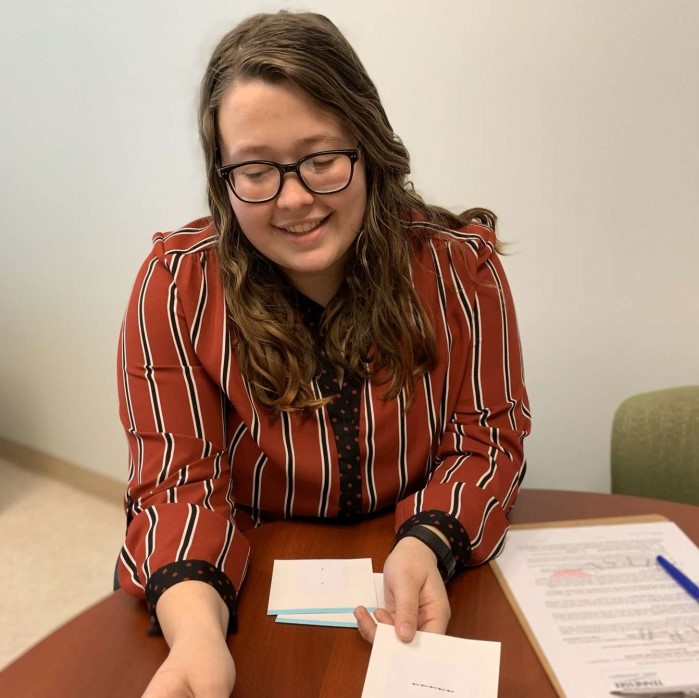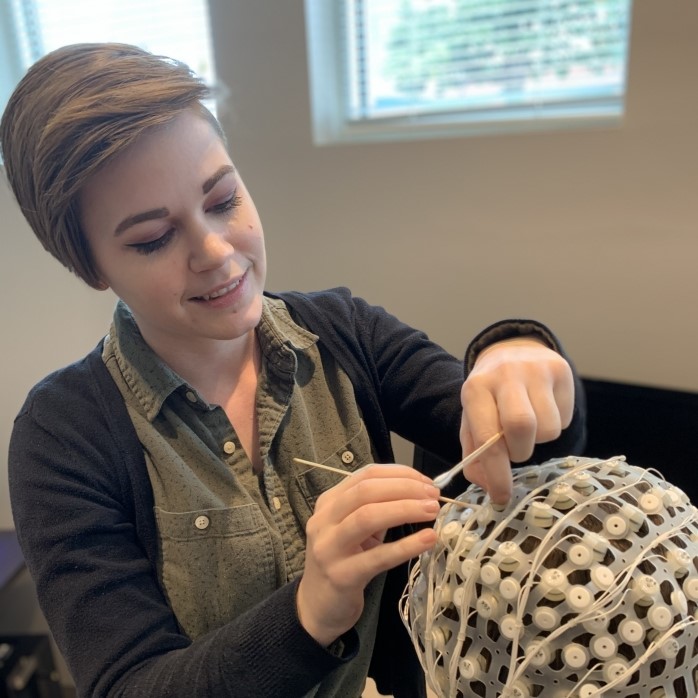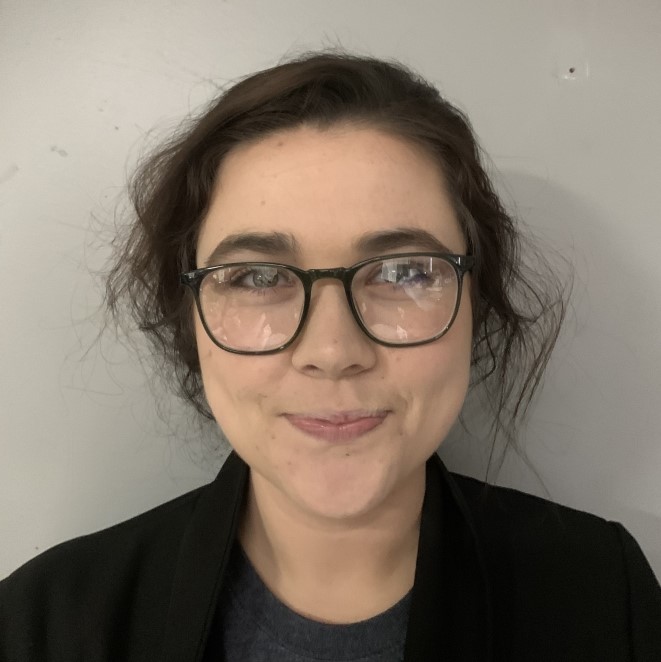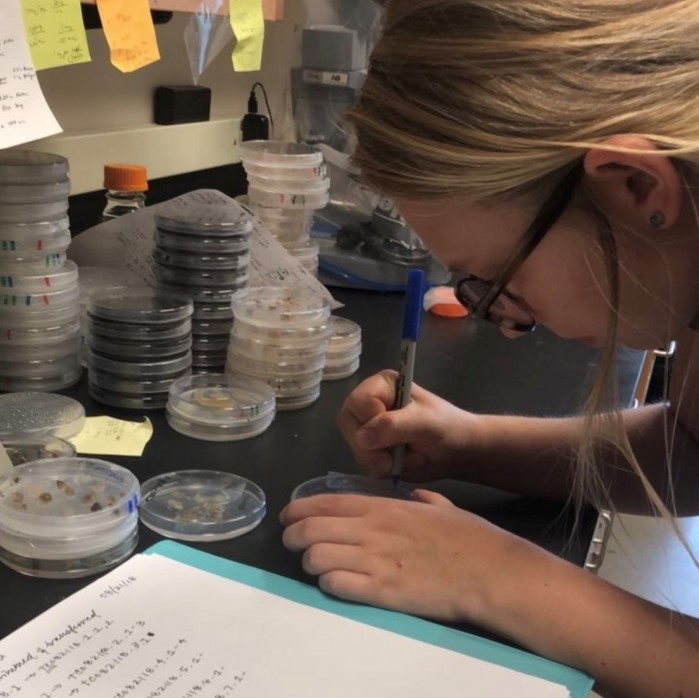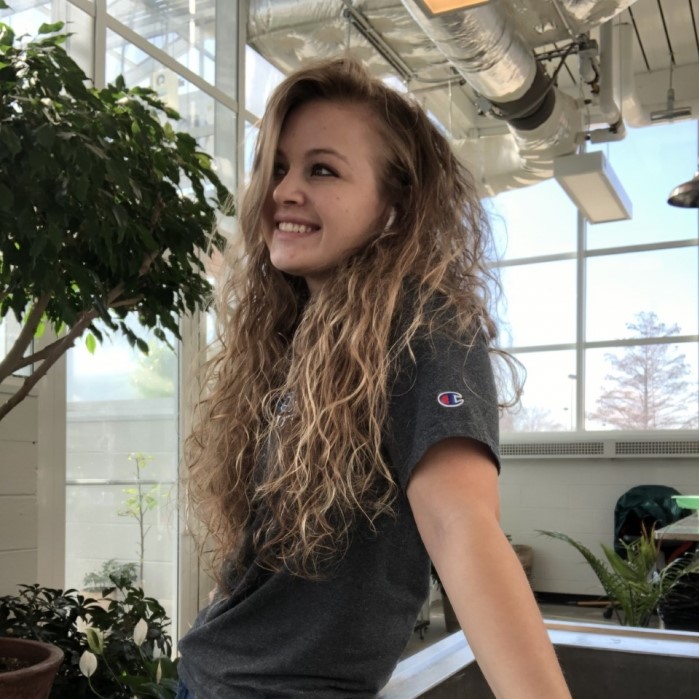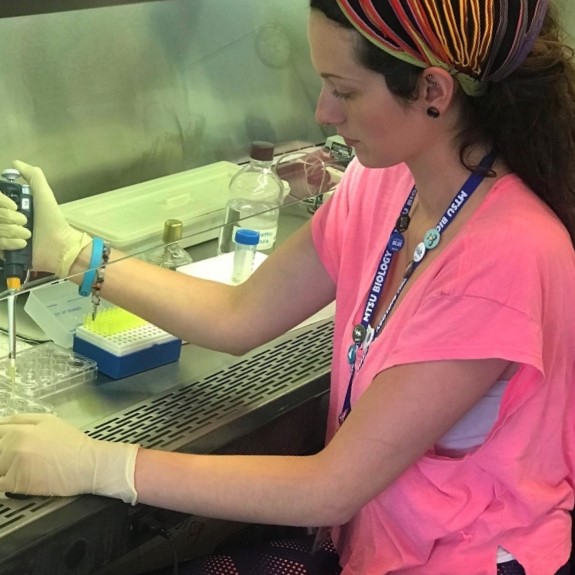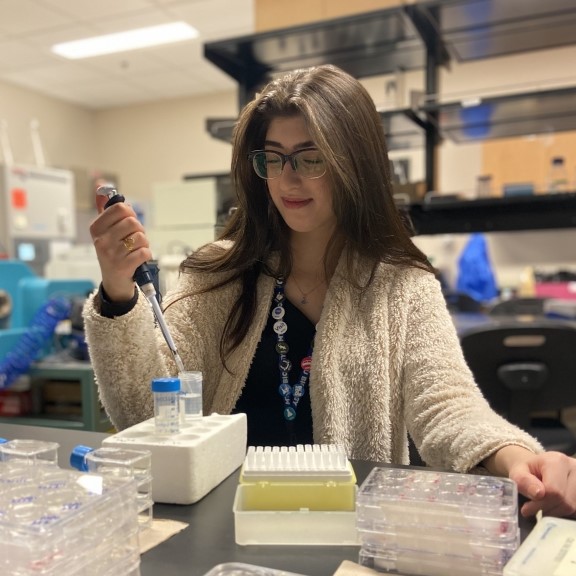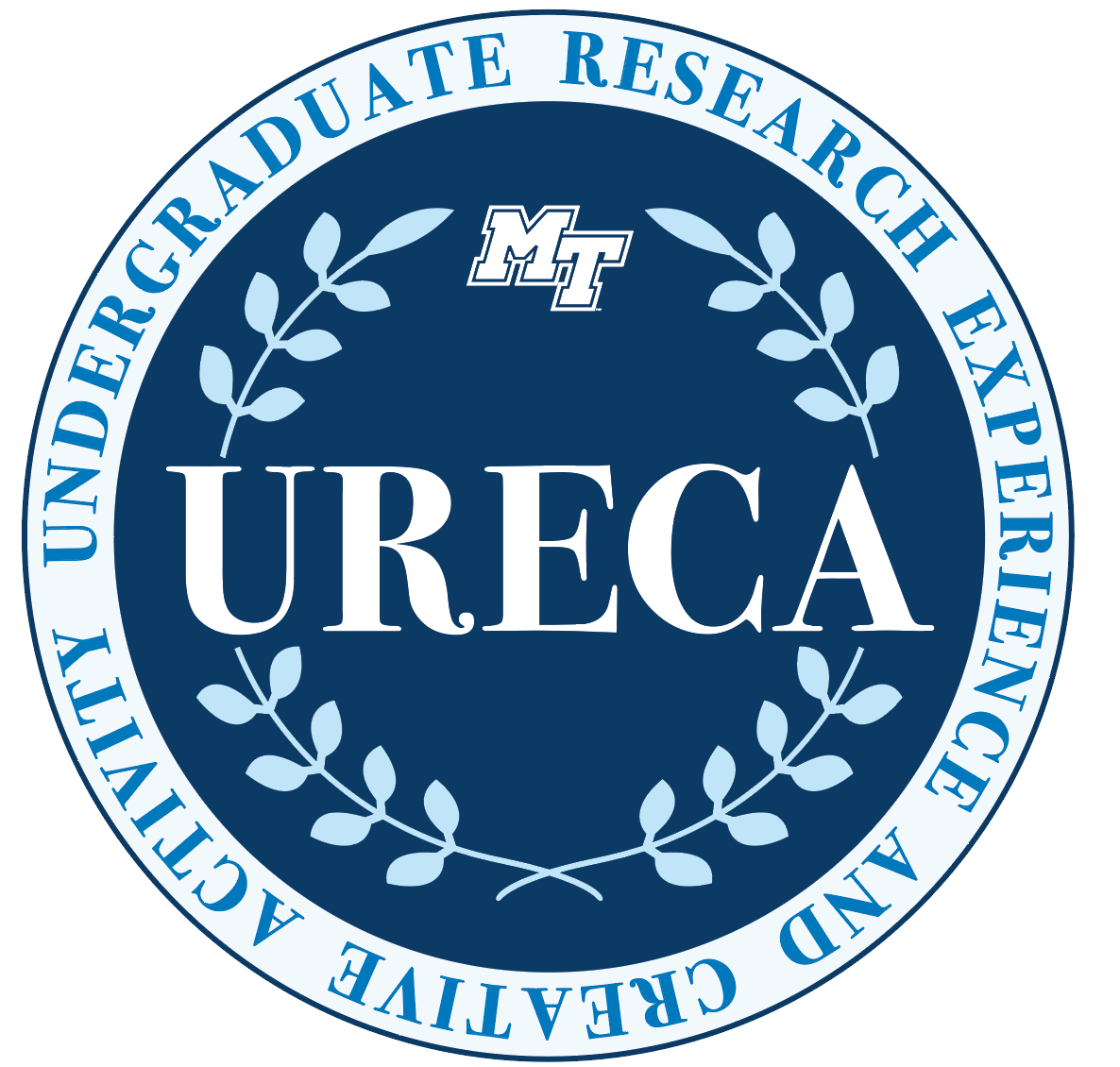National Conference on Undergraduate Research (NCUR) Presenters
MTSU's 2023 Selected NCUR Participants
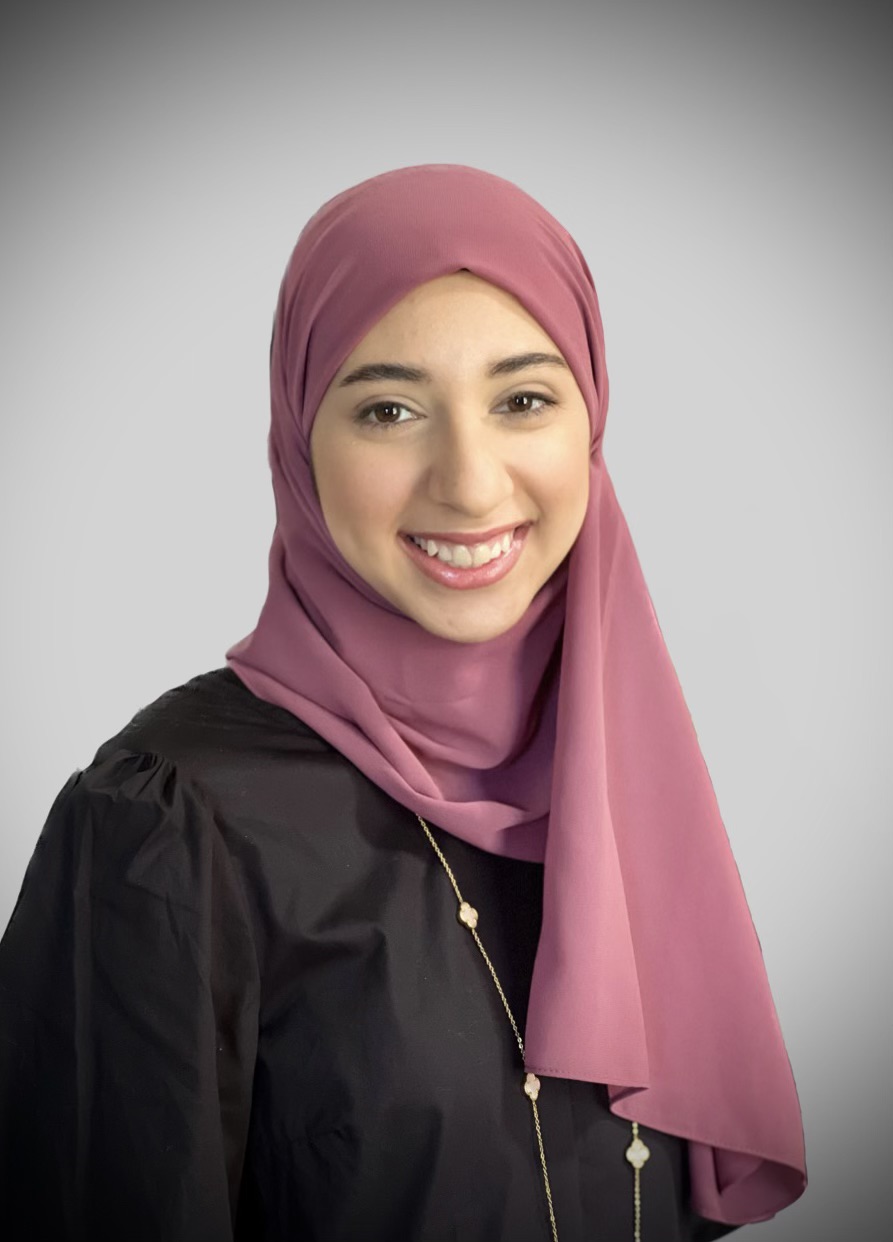 Janna Abou-Rahma
Janna Abou-Rahma
Mechanism of Action of Antifungal Peptoids
Faculty Mentor: Dr. Kevin Bicker
Due to the rise of drug resistant strains of fungal pathogens such as Cryptococcus neoformans and Candida albicans, there has been a need to identify new antifungal agents. In comparison to naturally produced antifungal peptides, antifungal peptoids, sequence-specific oligo-N-substituted glycines, mainly differ in structure, which prevents protease recognition giving higher bioavailability. Previous studies have shown that peptoids are effective fungicides. RMG8-8 and RMG9-11, two peptoids recently discovered in the Bicker Lab, have proven to be effective antifungal agents against C. neoformans and C. albicans, respectively. Reported here will be studies to determine the mechanism of action and other vital therapeutic properties of RMG8-8 and RMG9-11 using various biochemical and microbiological assays. Preliminary results of critical micelle concentration, the minimum concentration of a compound needed to form micelles, testing indicate that RMG8-8 as well as RMG9-11 do not exist as micelles at their minimum inhibitory concentrations, but rather function unimolecularly. Using a parallel artificial membrane permeability assay, it was found that RMG8-8 is likely unable to penetrate the blood brain barrier. However, RMG9-11 demonstrated good permeability, indicating that it may be able to penetrate the blood brain barrier to treat dangerous neurological infections of fungi. Subsequently, assays will be conducted in order to further understand the mechanism of action of both peptoid compounds to address the rising concern of drug resistant strains of fungal pathogens.

Hunter Brady
Chlorine Dioxide Gas as an Antiviral Agent: Development, Optimization, and Application, of an Antiviral Assay based on the MS2 Bacteriophage
Faculty Mentor: Dr. Anthony Newsome
Since the emergence of the SARS-CoV-2 virus, the need to identify antiviral agents to disinfect large areas has greatly increased. Chlorine dioxide (ClO2) gas has previously been identified as an antibacterial agent with strong oxidizing capabilities. The MS2 bacteriophage has previously been identified as a suitable surrogate for the development and application of virucide decontamination methods. The purpose of this study was to identify and assess the antiviral properties of ClO2 gas and to determine optimum physical conditions for potential deployment in support of current antiviral disinfection needs. Using the MS2 bacteriophage model system, preliminary studies used the double-layer agar plaque assay technique to evaluate the antiviral activity of ClO2 gas. Initial results support the use of ClO2 gas as an antiviral agent. Reduction of up to six logs was observed with treatments of 200 ppm of ClO2 gas following overnight treatment on a non-porous surface such as steel coupons. Lesser exposure times studies were also effective in multiple log reductions of the MS2 bacteriophage. Studies are now being directed at the ability to inactivate MS2 phage imbedded in porous surfaces such as cloth. It has been determined that infective MS2 bacteriophage can be recovered after being imbedded on a cloth substrate. This can serve as a basis to evaluate MS2 phage inactivation when imbedded in porous substrates such as cloth.
Brooke Busbee
READY (Research Experience Activity Designed for Youth) to SOAR Program and its Impact on Area High School Students
Faculty Mentor: Dr. Jamie Burriss
Very few university-wide programs offer high school students the opportunity to experience undergraduate research prior to enrolling in higher education courses. The READY (Research Experience Activity Designed for Youth) to SOAR program at Middle Tennessee State University (MTSU) was piloted during the 2021-2022 academic year and presented area high school students with an opportunity to visit campus for an immersive research and creative activity experience. The goal of the program is to showcase MTSU’s undergraduate research opportunities to potential students through a single-day engagement event. To enlighten our understanding of how high school students view undergraduate research, we will be administering a pre/post questionnaire to all participants. Our research questions surrounding this experience include the following: What is their current perspective on the terms “research” or “creative activity”? What is their level of interest in pursuing research as a future undergraduate student? And finally, what is their intended area of study, if known? The results of this study will aid our team in programmatic planning for future READY to SOAR events, help us to better understand how high school students perceive undergraduate research, and their level of interest in becoming involved in undergraduate research.
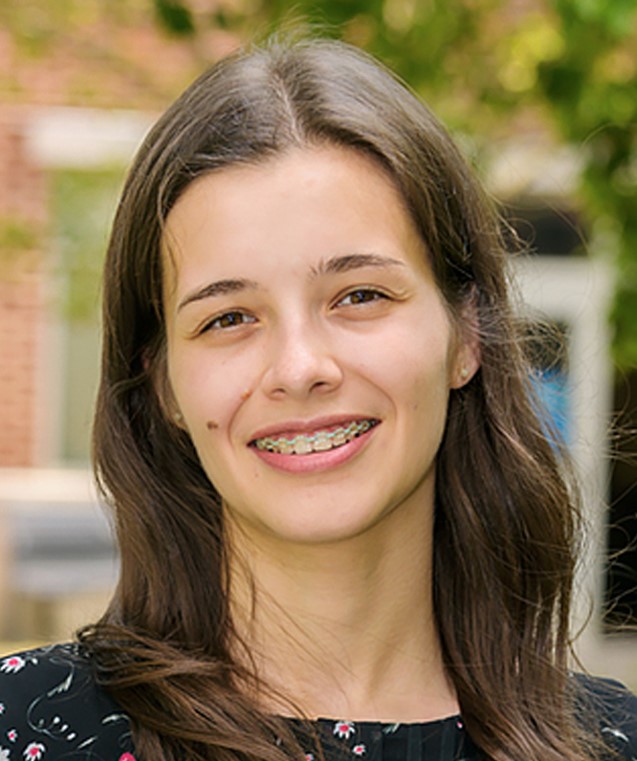
Greti Muller
Pionír: An Illustrated Novella Inspired by the Historical Pioneering Heritage of a Family from Transylvania
Faculty Mentor: Dr. Mary Evins
The creative thesis Pionír developed an illustrated novella inspired by accounts told to the author, Gréti Müller, by older generations of her family who lived under the Romanian communist regime and witnessed its overthrow in 1989. The title of the novella, “pionír” /ˌpaɪəˈnɪəɹ /—the Hungarian term for the English word “pioneer”— is meant to capture a central theme in the history of the author’s family, a motif reappearing throughout generations and enacted again in the 21st century in a pioneering move to the United States. Pionír was written to acknowledge and honor the individuals on whom the characters of the narrative are shaped. Their story of struggle, pioneering, overcoming, changing, growing, and moving forward can also hopefully bring richness and depth to the stories that comprise the immigrant heritage of the United States.
The work Pionír found its current expression through envelopes sewn together to form an artist’s book. Each envelope holds a chapter of the narrative along with works of art that reference parts of the storyline. At the expense of the aesthtetics of traditional illustration, the artistic component of Pionír is meant to engage the five senses of the “reader,” and to translate synesthesia into a form of art.
Through a narrative inspired by history and through the immediate experience of it as a work of art, Pionír tells a story that becomes an invitation open to everyone. The “reader” is called to make sense of it by relating the work to his/her life and cultural-historical heritage.

Foram Patel
Scaling GPA* for complex protein folding pathway simulations
Faculty Mentor: Dr. Joshua Phillips
Finding improved protein folding pathway modeling tools is crucial to develop more potent treatments for disorders caused by protein misfolding. The fast-folding streptococcal protein G (1GB1), which has alpha-helices and several beta-sheets, can be used to test models of protein folding. Pathway prediction is often computationally expensive and time-consuming, so current research focuses on accelerating Molecular Dynamics (MD) simulations. One of the common issues in protein folding simulations is the protein getting trapped in local minima of energy surface states until kinetic energy can drive it out. To fix this, past methods have imposed an unnatural bias on the potential and kinetic energies of the simulation environments. Finding unbiased methods for such simulations was an open problem and was addressed by (Syzonenko & Phillips, 2020), introducing a combination of the A* algorithm and MD simulations. This approach encourages progress that would otherwise be stifled due to the stochastic nature of MD simulations and is expected to lower the computing time required to acquire the folded conformation without adding artificial energy bias. The current implementation has storage issues due to system constraints preventing large-scale implementation. This was because there was an abundant amount of files produced. It is necessary to figure out methods to make the whole process scalable. A viable alternative could be the replacement of auxiliary file storage on disk with a key-value data structure for storage. This would prove less burdensome on the file systems. Instead of relying on GROMACS commands using OS system calls, the MDAnalysis library, which is based on GROMACS may be used for simulation commands and storing coordinates. Once validated on the complex and fast-folding 1GB1 protein, the approach may be applied to even larger α-β proteins.
Connor Prim
Musicianship Explored Through Mahler’s Fifth Symphony
Faculty Mentor: Dr. Michael Arndt
Gustav Mahler’s Symphony No. 5 represents one of the pinnacle orchestral works of the Romantic Era. In addition to its physically and emotionally demanding passages, it exquisitely expresses the beauty, heartache, and pain Mahler experienced throughout his life. Therefore, when performing his music, musicians must be careful to understand the grief that was Mahler’s muse and the solace he found in music. This thesis project aims to aid trumpet players in their understanding of the piece and its composer and assist in developing the technical and musical abilities necessary to perform this magnificent work.
Casey Tomlin
Sex and age estimation using CT images in Forensic Anthropology
Faculty Mentor: Dr. Yangseung Jeong
Forensic anthropologists reconstruct the biological profile (e.g., ancestry, sex, and age) of skeletal remains for victim identification at a crime scene. However, the preservation state of the skeletal remains may be compromised due to taphonomic factors, which requires alternative methods for assessing morphological features present on the bones. Bone mineral density (BMD) is known to be affected by sex and age of individuals. In this regard, sexual differences in BMD and its relationship with age have been studied. Recently, three-dimensional (3D) imaging technology such as computed tomography (CT) has been popularly used for forensic anthropological examination. The purpose of this study is to generate new methods for sex and age estimation from the Korean skeletal remains using CT data and related software. In this study, a new concept, digital bone loss (DBL), will be introduced. Whole body CT scan data from 240 Koreans (119 males, 121 females) were studied. Mean ages of the samples are 55.1 years and 53.6 years for males and females, respectively. Three open-source software (3D Slicer, Meshmixer, and CloudCompare) were used to calculate DBL. In this study, DBL is defined as the ratio of loss in the number of faces between two 3D models which are reconstructed using different thresholds in the Threshold tool of the Segment Editor module of 3D Slicer. Logistic regression models and linear regression models were generated for sex and age estimation, respectively. This study suggests that DBL can be possibly used as a proxy for BMD and thus, can serve as an indicator for sex and age estimation in forensic anthropology.
Lindsey Tran
Creation of electro-magnetic assisted “Star-like” formation from cancer cells using laser trapping technology
Faculty Mentor: Dr. Daniel Erenso
Cancer is the second leading cause of death among humans worldwide. Although radiation therapy is the most effective course of treatment for patients, it still causes harmful and long-lasting damage to their bodies, ruining their quality of life. The initial purpose of this study was to minimize radiation damage caused by cancer treatment using laser-trapping (LT) technology. However, amidst experimentation, two scientific phenomena were discovered: "Dark-space" and "Star-like" formations. Both discoveries were observed to have power absorption and conservation abilities, which can be utilized in the world’s constant technological advancements. Thus, the purpose of this study was expanded into 3 phases: Single-cell ionization, "Dark-space" formation, and "Star-like" formation. Phase 1 used an infrared laser trap to find the minimal radiation required to ionize a BT20 cancer cell. A 3:1 mixture solution of BT20 cancer cells and micron-size magnetic beads was instilled onto a depression slide and used to conduct measurements for over four years. Further, on to Phase 2, a "Dark-space" forms when the magnetic beads and cells interact with the laser trap that acts as an energy storage capacitor and rapidly expands as more and more radiation is absorbed. This expansion causes all surrounding matter to accelerate towards the dark region, yet it can never penetrate the space. Upon explosion, the energy of the "Dark-space" causes the surrounding matter to form into a plasma. Leading into Phase 3, a "Star-like" illumination forms once the plasma interacts with the laser trap. This interaction causes an emission of intense blackbody radiation that grows and becomes more robust as more energy is absorbed. Overall, applications of this study may provide improvements in cancer treatment, microchip technology, and solar energy harvesting.

Tecka VanTrease
Evaluating School Professionals Knowledge of Dyslexia
Faculty Mentor: Dr. Kathryn Blankenship
Speech-language pathologists and educators play a vital role in the academic success
of students
with dyslexia. Due to the common misconceptions that have surfaced, school professionals
may
experience confusion regarding what dyslexia is and what their role in remediation
may be.
Researchers have found that pre-service students and in-service school personnel fall
victim to
myths about dyslexia or lack knowledge of the topic in general. The purpose of this
study was to
evaluate and compare the accuracy and confidence of dyslexia knowledge among various
groups of educators (N = 199) including speech language pathologists (n = 68), K-12
teachers (n = 62), and reading specialists (n = 69). To our knowledge, no other studies
have assessed dyslexia knowledge and confidence among the previously mentioned groups.
Using a Likert scale formatted survey, this study qualitatively assessed educators’
knowledge of common dyslexia characteristics. Item analyses revealed that reading
specialists were most accurate in their responses when compared to the literature.
Consistent with item accuracy, reading specialists also reported higher confidence
in their abilities to effectively work with children with dyslexia. Even though reading
specialists' confidence levels were high, there was a lack of confidence among all
groups in formal education preparation for dyslexia. The findings indicate an increased
need for in-service training and modification of educational curriculums to include
explicit dyslexia instruction.
 Ross Sibley
Ross Sibley
Synthesis and Characterization of Cyclic Peptoids Against Cryptococcus neoformans and Candida albicans
Faculty Mentor: Dr. Kevin Bicker
Synthesis and Characterization of Cyclic Peptoids Against Cryptococcus neoformans and Candida albicans
Antimicrobial resistant strains of fungal pathogens such as Cryptococcus neoformans and Candida albicans have risen to concerning heights, necessitating the discovery of a safe and effective novel antimicrobial agent. Antifungal peptoids, or peptidomimetic N-substituted glycines, have great potential when it comes to acting as antifungal agents due to greater bioavailability and stability towards proteases compared to their peptide counterparts. RMG8-8 and RMG9-11 are two peptoids recently discovered in the Bicker Lab with observed antifungal activity against Cryptococcus neoformans and Candida albicans, respectively. While these peptoids have comparable activity in vitro to current antifungals on the market, this study attempts to optimize antifungal activity by cyclizing the aforementioned linear peptoids with the hope that increased rigidity due to a locked conformation will increase the antifungal activity of the antifungal peptoids without affecting the observed permeability. Additionally, peptoids are synthesized via solid-phase synthesis, a relatively cheap method that eliminates intermediate purification, further contributing to potential success as a viable treatment. To characterize the extent of efficacy, cyclic RMG8-8 (RHS3) and cyclic RMG9-11 (RHS6) have been tested for minimum inhibitory concentrations (MIC) against Cryptococcus neoformans and Candida albicans which will be reported. Future analysis will include mammalian cytotoxicity on HepG2 liver cells and hemolytic activity against human erythrocytes (red blood cells) to determine whether these peptoids are viable options moving towards animal studies and clinical trials.
 Yaseen Ginnab
Yaseen Ginnab
Analyzing the Ability of Astragalus tennesseensis to Accumulate Selenium
Faculty Mentor: Dr. Frank Bailey
Selenium is a naturally-occuring essential micronutrient that can be accumulated by some plants. When accumulated above 1,000 µg Se per g−1 DW, the plant is a selenium hyperaccumulator. Astragalus bisulcatus is one of the most well-studied hyperaccumulators. Astragalus tennesseensis is a related species and currently has no literature observing its ability to accumulate selenium. This project will investigate whether A. tennesseensis can accumulate selenium. Both species were grown in a greenhouse to compare their reactions to the presence of selenium. Sodium selenate (Na2SeO4) was applied to test groups. After treatment is completed, the plants will be digested in nitric acid and analyzed by inductively coupled plasma optical emission spectroscopy (ICP-OES) to determine the selenium content. A. tennesseensis’s typical environment has relatively low selenium, so it is reasonable to assume that it will not be as efficient as A. bisulcatus and may not reach the hyperaccumulator threshold. Moving forward from this project, researchers can observe whether selenium is accumulated differently in the various plant parts. Another question is how the plant incorporates selenium into its tissues; selenium often replaces sulfur in amino acids and may be stored in several different forms.
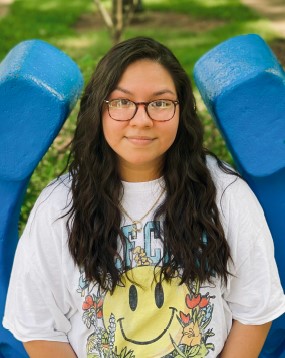 Leslie Gonzalez Salazar
Leslie Gonzalez Salazar
Sex and age estimation using CT images in Forensic Anthropology; READY (Research Experience Activity Designed for Youth) to SOAR Program and its Impact on Area High School Students
Faculty Mentor: Dr. Yangseung Jeong
Forensic anthropologists reconstruct the biological profile (e.g., ancestry, sex, and age) of skeletal remains for victim identification at a crime scene. However, the preservation state of the skeletal remains may be compromised due to taphonomic factors, which requires alternative methods for assessing morphological features present on the bones. Bone mineral density (BMD) is known to be affected by sex and age of individuals. In this regard, sexual differences in BMD and its relationship with age have been studied. Recently, three-dimensional (3D) imaging technology such as computed tomography (CT) has been popularly used for forensic anthropological examination. The purpose of this study is to generate new methods for sex and age estimation from the Korean skeletal remains using CT data and related software. In this study, a new concept, digital bone loss (DBL), will be introduced. Whole body CT scan data from 240 Koreans (119 males, 121 females) were studied. Mean ages of the samples are 55.1 years and 53.6 years for males and females, respectively. Three open-source software (3D Slicer, Meshmixer, and CloudCompare) were used to calculate DBL. In this study, DBL is defined as the ratio of loss in the number of faces between two 3D models which are reconstructed using different thresholds in the Threshold tool of the Segment Editor module of 3D Slicer. Logistic regression models and linear regression models were generated for sex and age estimation, respectively. This study suggests that DBL can be possibly used as a proxy for BMD and thus, can serve as an indicator for sex and age estimation in forensic anthropology.
 Marzea Akter
Marzea Akter
Effect of acute oxytocin administration on social behavior in male and female mice
Faculty Mentor: Dr. Tiffany Rogers
Oxytocin is a neurotransmitter and hormone with a well-established role in prosocial behaviors in animals and humans. It is currently being tested in clinical trials for the treatments of social symptoms associated with autism spectrum disorders. However, the behavioral effects of oxytocin treatment have been variable with both prosocial (increased empathy) and antisocial (increased competitiveness) behaviors resulting in humans. Previous studies in our lab have shown increased anxiety-like behaviors in mice treated chronically with oxytocin (1 12 ug dose per day for 14 consecutive days, data unpublished). The current study aims to see the effect of acute oxytocin administration on social behavior in male and female mice to determine if the schedule of oxytocin administration affects behavioral outcomes. Adult C57BL/6J mice will be acutely pretreted with saline or oxytocin (12 μg) an hour before the behavior tests. Saline or oxytocin will be administered either intranasally (i.n., 12 ug in 12 uL per nostril) or intraperitoneally (i.p., 12 ug in 123uL). Mice will complete a battery of behavioral tests including the elevated plus maze (EPM), three-chamber sociability task (3C), and free dyadic social interaction (FDSI) after drug administration to detemine changes in social behavior and anxiety-like behavior. Noldus EthoVision XT and human coders will code anxiety-like behaviors, social preference, and social novelty. I expect to find that acute oxytocin administration will increase sociability as measure by the 3C and FDSI tasks while avoiding increases in anxiety-like behaviors, as measured by the EPM task, associated with chronic administration.
Ariel Nicastro
Electrical ring resonator: Experiments and program development
Weston Williams
Rapid Foodborne Pathogen Detection via Tangential Flow Nano/Microfilter Bioseperation System
Luke Gormsen
Electrical ring resonator: Experiments and program development
Joseph Vantrease
Metamorphosis


